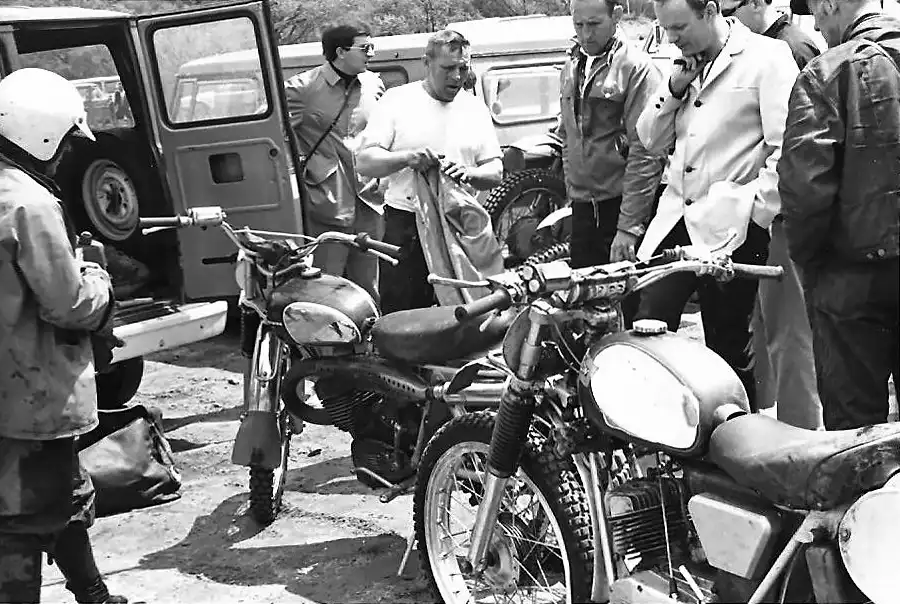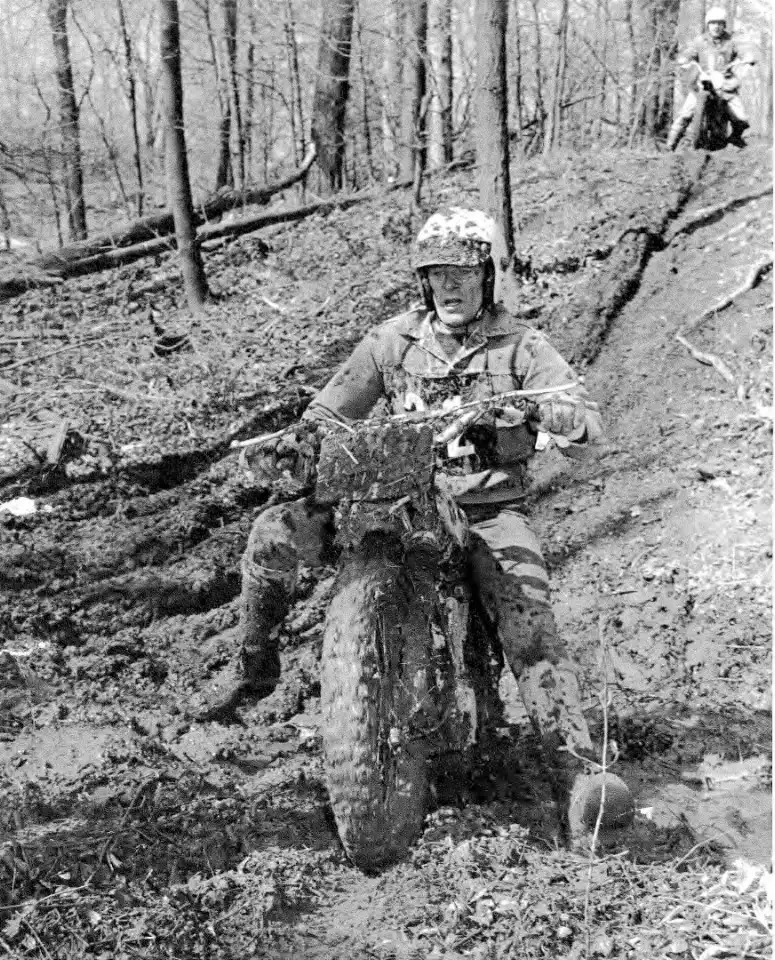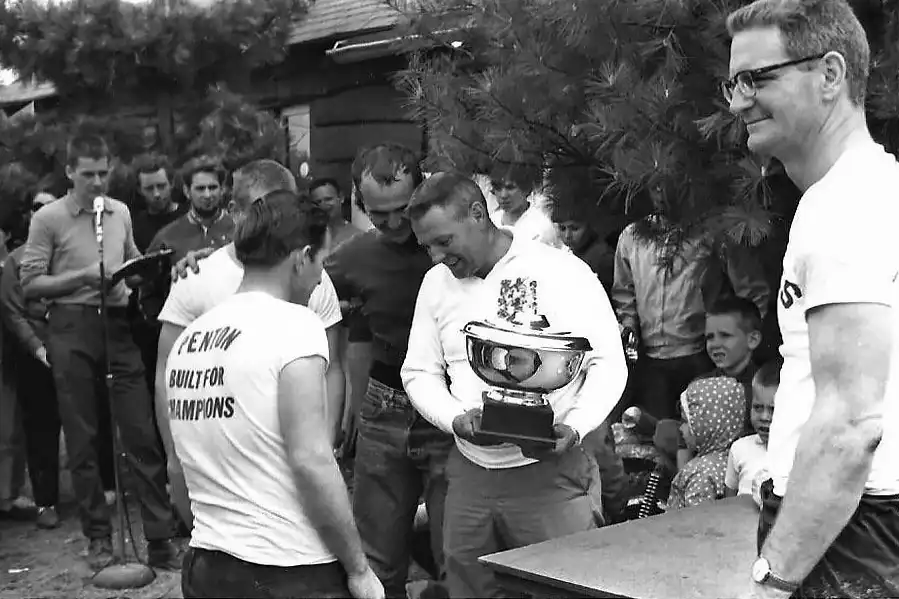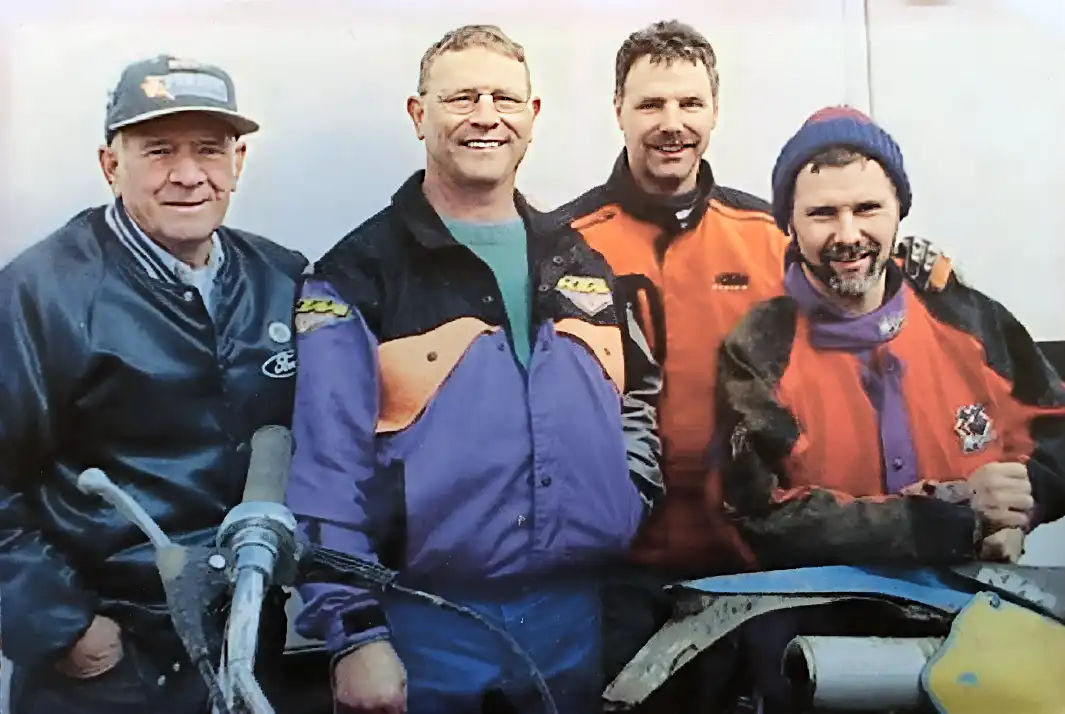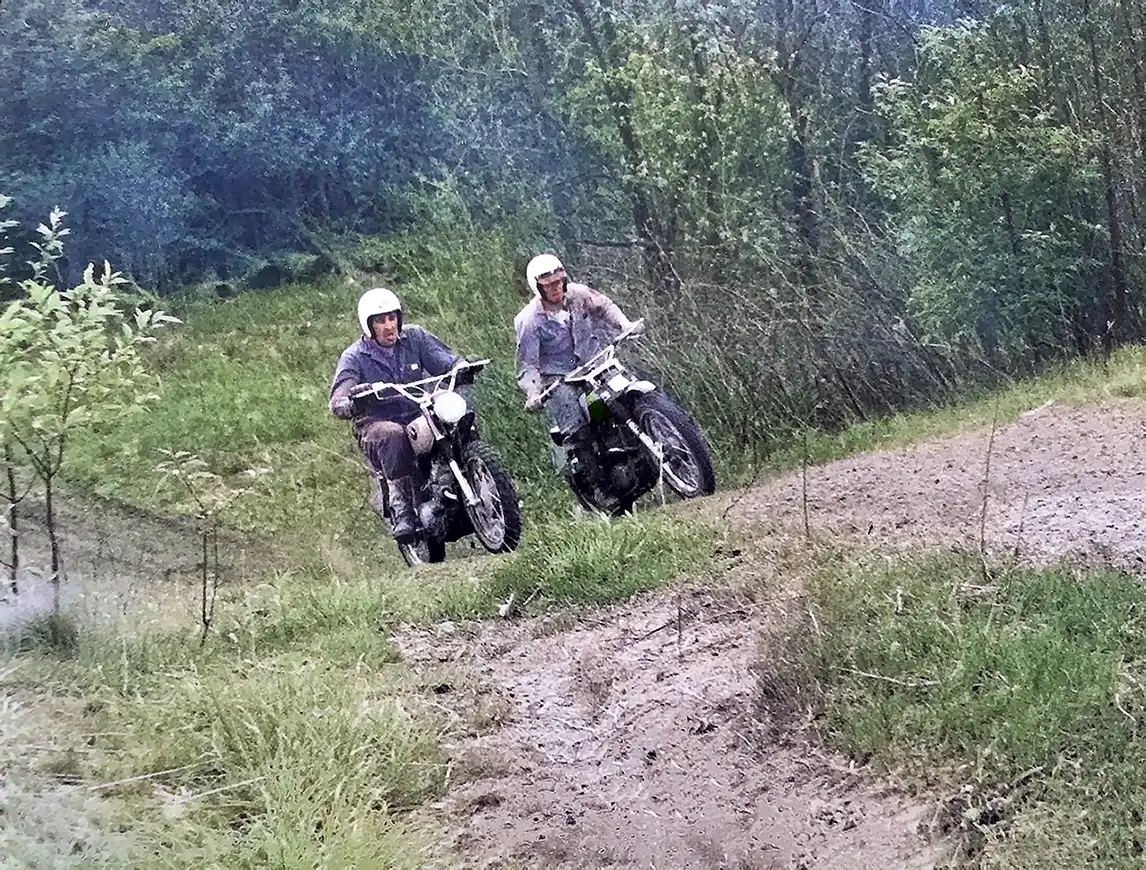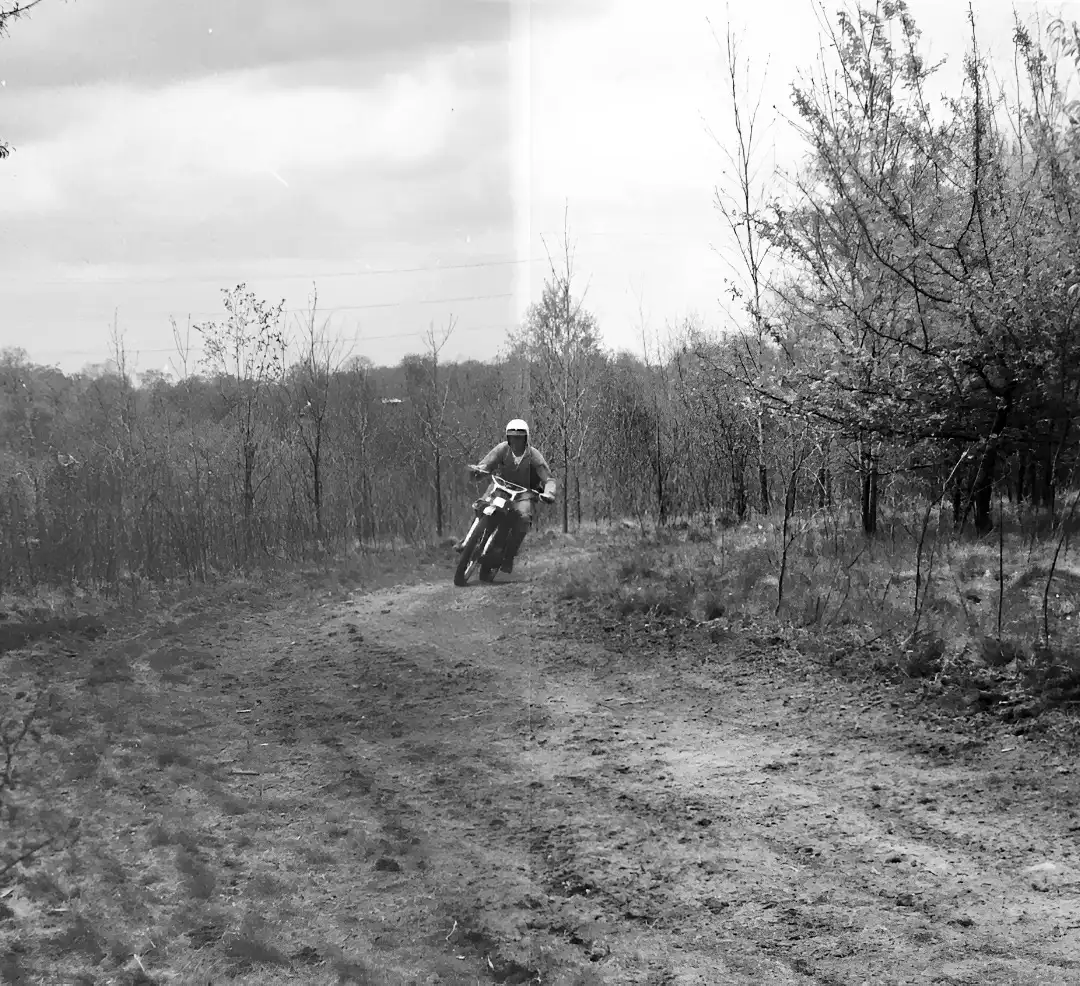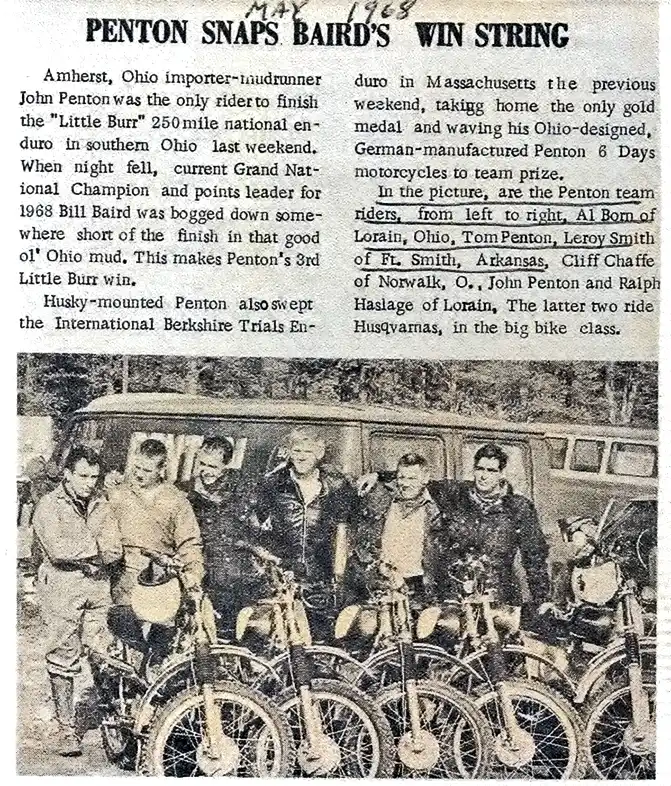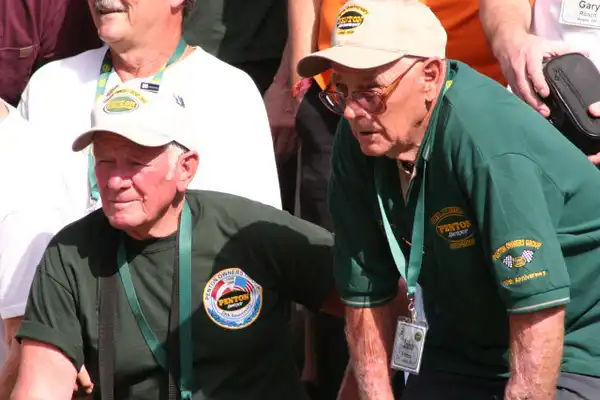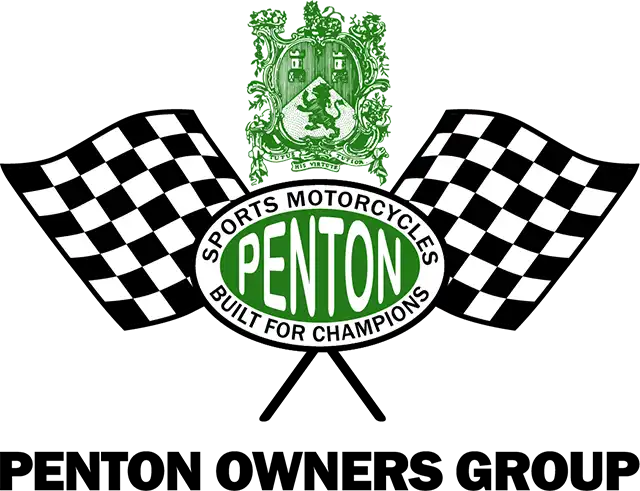Dwight Rudder
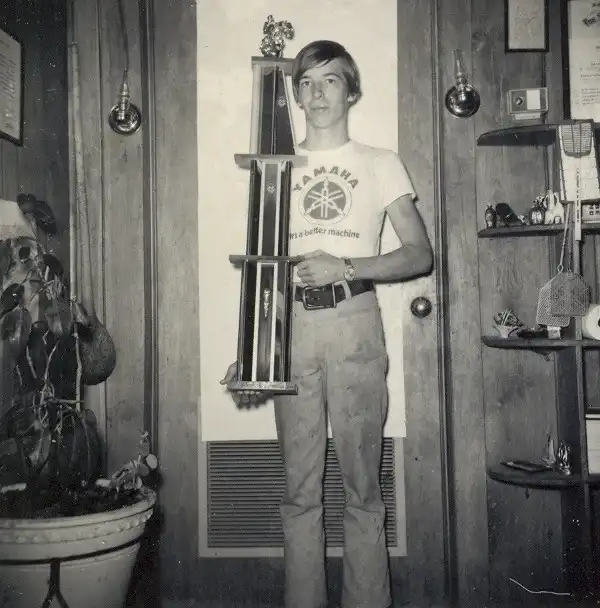
BEEN THERE, DONE THAT
by Ted Guthrie
Originally printed in the 2009 issue #43of Still….Keeping Track
Alabama native Dwight Rudder is “the real deal”. He’s been on numerous factory enduro teams, earned medals in multiple ISDT competitions, has been an “A” enduro rider for decades, and those are just a few of his motorcycling accomplishments. There is in fact a lot more to this quiet, polite fellow with the southern drawl, besides.
Dwight was raised in Greensboro, Alabama, hence the southern accent. However, where his exceptional motorcycle riding skills came from is anyone’s guess. He didn’t come from a motorcycling family, but Dwight’s father did introduce him to the sport at age 9 with the gift of a lawnmower engine-powered minibike. Dad also had a Harley 165 stashed in the barn, which was brought out and coaxed back into operation when Dwight was 12. While Dwight did put some time on the bike, he was initially scared of it. Later came another minibike, but then Dwight graduated to a Suzuki T250 Scrambler. Despite its rough and ready moniker, the Suzuki didn’t turn out to be a very good trail bike. As a result, Dwight traded it for a ’69 Yamaha AT1, aboard which he rode his first enduro in 1971 in Brent, Alabama and his second a few weeks later at the famous “GOBBLER GETTER ENDURO” in Maplesville, Alabama.
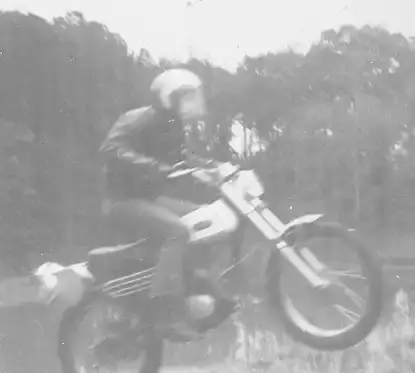
Along about this same time, Dwight’s father took him to see the motorcycling film classic, “On Any Sunday”. Although Dwight enjoyed the entire film immensely, it was the segment which featured Malcolm Smith’s performance in the International Six-Day Trial that really excited the young racer. Right then and there Dwight decided that ISDTtype competition was going to be his primary pursuit and Malcolm Smith became his number one hero. So, how did a young man correspond with his hero back in the 1970’s? Why write fan letters, of course. And, being the friendly guy that he is, Malcolm responded with letters of his own, as well as photographs of himself and his motorcycles.
Meanwhile, Dwight had moved on to a Yamaha CT-2 175, followed by a 175 Jackpiner, and then a Penton 125 Six-Day, on which he began competing in 2-Day Qualifiers. At the Ft. Hood, Texas Qualifier, in 1975, Dwight had stopped alongside the trail to fix a problem with his Penton’s throttle cable when none other than Malcolm Smith himself stopped to see if he needed any assistance. Dwight already had the cable repaired, but he did however accept Malcolm’s offer for them to ride together. And so it was it was that Dwight found himself riding in the company of his boyhood hero.
This very special experience came to a premature end though, when Dwight’s 125 Six-Day sheared its shift key. By the time Dwight managed to get in off the course, it was late and nearly everyone else was packed up and gone. Among those still around however was Malcolm, who promptly came over to talk to Dwight. Malcolm complimented the young Penton rider on his fine ride earlier in the day and when Dwight introduced himself, Malcolm’s eyes went wide and he took a step back. “There used to be a kid by that name that wrote fan letters to me!”, he said, partly surprised and more than a little impressed as Dwight turned a very embarrassed red. Dwight recalls that he will never forget this initial meeting with Malcolm Smith. The entire experience, from riding with his hero, to Malcolm actually remembering him from the fan letters, absolutely galvanized Dwight’s opinion of Malcolm Smith as a top rider and as a wonderful person and they remain friends to this day. Dwight Rudder rode this prototype 125cc
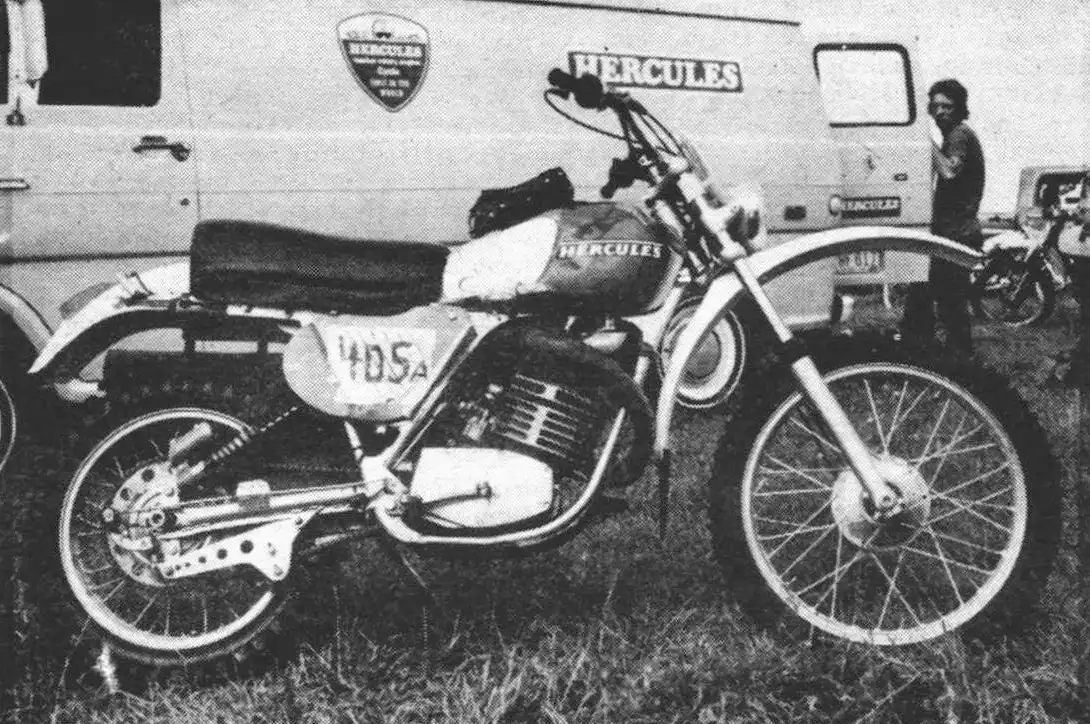
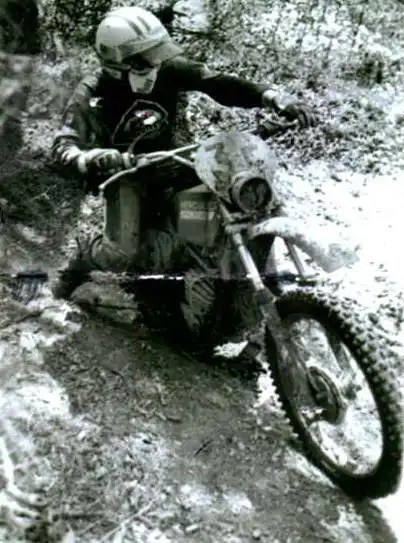
Dwight continued competing in the Qualifiers, and did quite well. He met the Penton family and the entire Penton team, and was very honored when Dane Leimbach invited him to pit out of the famed Penton Cycleliner. Then, during the offseason, just after moving from Alabama to a new home in Jackson, Mississippi, Dwight was contacted by Doug Wilford, with an offer to ride Hercules motorcycles the following year. Doug had at that time recently taken a position with the Hercules importer and recognized the talent and potential of this young rider.
The first time Dwight had any experience at all with the Hercules motorcycles was early September, 1975, when he met with Doug at Tennessee’s Loco Ciento 1-Day Qualifier. There, he rode a prototype 7-speed Hercules 125. Despite drowning the bike out in a creek crossing due to what Dwight determined later to be poorly placed louvers in the airbox opening, Dwight tied for 2nd place in the 125 class with his friend, Teddy Leimbach. Steadily gaining experience through this and other strong rides aboard both six and seven-speed Hercules 125 and 175 models, Dwight remained with the team from 1975 through 1977.
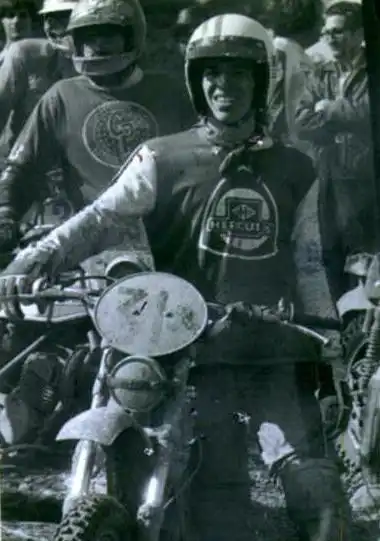
Dwight’s performances during this time qualified him to ride the ISDT in ’76. Unfortunately, he was denied the opportunity by Al Eames, who told Dwight that he didn’t have enough experience. “Rider selection for the ISDT team was not an entirely Democratic process back then”, Dwight comments dryly. Dwight also qualified to ride the ISDT in 1977, but was injured prior to the event. This particular injury was not the result of either a motorcycle riding or racing accident, but rather from another aspect of Dwight’s amazing life experiences.
This goes back to Dwight’s father, who was in the Air Force. Although Mr. Rudder did not serve in the USAF as a pilot, he did earn his pilot’s license while in the service. He then started his own crop dusting service in Alabama and later in Mississippi. Exposed to his father’s experience and influence, Dwight earned his student pilot’s license at age 14, followed by a commercial pilot’s license as soon as it was legal to take the test. And so, it was in one of his father’s crop dusting planes that Dwight suffered injuries which prevented him from participating in the 1977 ISDT. While flying over a particular farm field in Canton, Mississippi, while crop dusting, Dwight saw that the aircraft was going to come too close to some power lines. He managed to avoid the power lines by flying under them, but then could not quite clear the trees on the other side. A large tree ripped one of the plane’s wings entirely off, causing the aircraft to spin three times before crashing into the ground. Dwight suffered a broken collarbone, as well as a concussion so severe that it left him blind for several days. This unfortunate situation did result in one positive however, as it was during his recovery time that Dwight began to date a young lady named Debbie whom he had met some time before. The courtship blossomed and Dwight and Debbie eventually married, the union having lasted now for more than 30 years.
The year after his accident, Dwight was selected to ride on the brand-new Yamaha factory enduro team, along with Dane Leimbach, Carl Cranke, Chris Carter, and Jim Fishback. And, Dwight once again qualified well enough to ride the ISDT. Once again however, he was denied the chance to ride the event, this time by “team politics”, as Dwight puts it. The AMA wanted a SWM rider on the team and told Dwight that they had enough Yamaha riders. (That SWM rider went out on Day 2).
The Yamaha ride lasted only through the 1978 season, as the team was dissolved after just one year. However, Dwight did pick up partial support from Suzuki for 1979, and aboard the yellow bikes rode his first ISDT, held that year in Germany where Dwight earned a silver medal. Riding for Suzuki again in 1980, Dwight missed out on that year’s ISDT due to a dislocated ankle suffered at the Trask Mountain Qualifier.
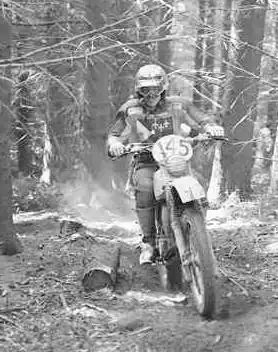
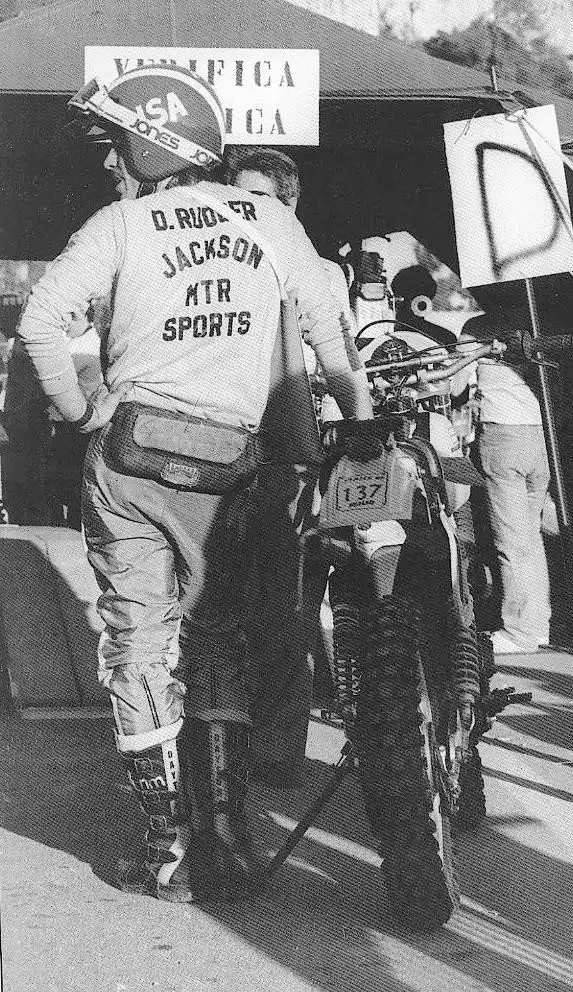
In 1981, Dwight was convinced by Suzuki to assist in creating and campaigning a one-off concept enduro bike. The machine was based on an RM125 motocrosser, but was fitted with different gearing, altered power characteristics, modified suspension, a lighting coil, enduro lighting, and a larger fuel tank. This motorcycle became the world’s only factory PE125. Dwight qualified on the bike for the ISDT, which was held that year on the Island of Elba, located in the Mediterranean Sea. The Suzuki performed well, and Dwight was well on his way to earning his first gold medal when the bike’s pipe cracked during the final moto. The resulting devastating loss of power dropped Dwight in the field, resulting in a silver medal finish. Surely an outstanding performance regardless, but sadly just short of Dwight’s ultimate goal.
In 1982 Dwight signed on for a support ride with Husqvarna to campaign a 125XC. He qualified once again for the ISDT, held that year in Czechoslovakia, an event which would become known as one of the toughest ever in the history of the Six-Day Trial. In terrible conditions rain, cold, mud, and more rain, over some of the toughest terrain imaginable, all the riders in the event struggled.
Dwight performed well on the little 125 Husky until the third day when he blew out his knee. He continued to ride however, in tremendous pain, and unable to even stand on his right leg. Also, through a combination of the wet and cold conditions, Dwight suffered hypothermia. And yet, through shear determination and by carefully limiting use of his injured knee, Dwight managed to finish the event - one of only 8 Americans to finish, out of 36 that started. He credits part of this accomplishment to, of all sources, riders from the Czech team with whom he had made friends. These competitors, who had dropped out of the event due to mechanical problems, would go out to the really impossible sections of trail and wait for Dwight to come along, then help him through. Such outside assistance was not entirely illegal in this particular ISDT, as even event Course Marshals were involved in assisting riders through certain impassable areas. The conditions were that tough.
For the 1983 season, Dwight decided to switch to competing in the U.S. National Enduro series. He started out riding a private Maico Enduro, but soon decided the bike was not well suited for enduro competition. He then switched to a 250XC Husky, and promptly won the A-class overall in his first National Enduro (Little Harpeth Nat’l Enduro). Dwight went on to finish the season first 250A, Overall A, and 5th overall for the year, then moved up to the AA class. In 1985 he rode a 350 KTM, then in 1986 was selected to ride for Kawasaki’s Team Green, on a KDX200. Dwight enjoyed a number of good rides aboard the KDX that year, including a third place overall in the Jack Pine Enduro.
In 1987, Al Baker offered Dwight a ride on XR250 Hondas. Together with Al, Dwight modified the bikes, increasing displacement to 280cc, along with numerous other modifications and improvements. On one of these XR’s, Dwight rode the ISDT that year in Poland, competing in the 350 class. Riding on Gold time, Dwight crashed hard on the last day. He got up and continued on, but at the next checkpoint noticed oil leaking badly from the bike. An inspection showed that the crash had apparently knocked a hole in one of the sidecases. Working frantically, Dwight was able to clean the case well enough to get some epoxy to at least stem the oil loss. Armed with a couple of extra bottles of oil, Dwight took off down the trail. He had lost much time however, and saw his gold medal slip to a bronze by the finish.
Determined to wring even more power from the XR250 motor for the next year, Dwight punched it out to 300cc and installed a custom built Poweroll stroker crank. Despite Al Baker’s concerns that the motor would never last, Dwight began competing on the bike and found it to be reliable as well as a virtual rocket. Unfortunately, on the eve of that year’s ISDT while putting the bike through final tuning, the engine did blow up. In desperation, and with no time to spare, Dwight and Al took the motor from Al’s personal XR and installed it in Dwight’s bike. While not on par with the power Dwight had built into his own motor, the one from Al’s bike would have to do. Only one problem – Dwight noticed that there were no serial numbers on the cases. Al explained that through all the development work he had done on the motor, the cases were “replacement” parts and so had no factory serial stampings. With nothing to lose, Al produced a set of metal engraving stamps and he and Dwight proceeded to mark the cases with the ID: “OICU812”. And, with this fictional serial number the bike passed tech inspection and Dwight rode it successfully in that year’s ISDT.
For the 1989 season, Dwight duplicated his ’88 XR300, but this time supplemented with a higherperformance cam, supplied by Mega- Cycle. The stroker crank was once again employed as well. Dwight had determined that the ’88 failure was the result of a mechanic failing to re-weld the crank properly, and so felt confident of the reliability of this setup. Besides, the bike was now even more of a rocketship. Dwight reports that the power he got out of the little four-stroke engine was just amazing. And, the bike’s overall performance was vilified by Dwight’s successful ride to a Gold in the German ISDT that year.
For 1990, Dwight went back to Suzuki for a season, riding a DR350. Aboard it, he won the 4 stroke A class in National Enduro competition. Then, for the next few years he returned to riding Honda XR’s – but this time on the booming 600’s. For several years he continued to ride the big Honda four-strokes, regularly winning his class in national competition. Dwight’s final ISDT appearance was in 1994, when he competed once again on a modified XR250 (315cc) Honda, and earned a silver medal. In his 7 ISDT and ISDE competitions, Dwight earned 1 gold, 4 silvers, and 2 bronze medals, finishing every event.
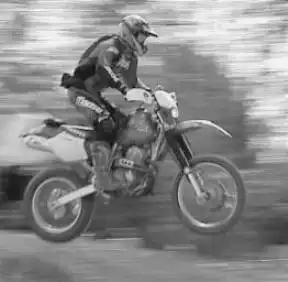
So, with all these experiences under his belt, what is Dwight Rudder up to these days? Well, he still competes occasionally in National Enduros, and consistently places well in the Super Senior Class. He also rides the Senior A class in Southern Enduro Riders Association events. He also collects vintage motorcycles, which presently number “about 70” according to Dwight. Note that all of these bikes are “riders”, and almost all are vintage enduro bikes. Dwight has a couple of older street bikes, including a 1989 Honda GB500 single – well known among collectors for its classic British club-racer styling. And of course several Pentons are part of Dwight’s collection, including at present a Steel-Tanker Bershire, a Steel-Tanker Six-Day, a CMF Six- Day, and a ’73 Jackpiner. His preference in regard to collecting and maintaining his bikes is originality, Dwight reports. He likes the bikes to maintain their original appearance and performance. There are a few exceptions of course, such as his slightly modified 1987 Honda XR200R that he rides in Post- Vintage and modern events, as well as a somewhat “breathed-on”, modern, aircooled, Honda CR230F that he is currently racing in the modern Enduros and in Hare Scrambles. Dwight is also a history buff, participating in Civil War reenactments. And, he maintains his pilot’s license and love of flying as well, having recently owned and flown a replica of a 1916 WWI French Nieuport aircraft.
Dwight has worked for the wholesale motorcycle parts distributor, Parts Unlimited since 1987. Wife Debbie is involved with the motorcycling sport as well, having pitted back in the old days not only for Dwight, but for the Yamaha and later the Suzuki and Husqvarna Enduro Teams. Today, Debbie continues a role she has held for some years as the Secretary/Treasurer of the Southern Enduro Riders Association. “She knows her stuff, too” Dwight says. “Why, over the years many top riders such as Dick Burleson have approached her to ask questions in regard to the association’s rules and regulations.” Debbie tried her hand at enduro competition, but these days is content primarily to zip around to gas stops on her street-licensed Yamaha TTR125.
When asked about stories from the old days, Dwight says that he hardly knows where to start. Some of the stories involve riding and racing of course, but there are also “behind the scenes” recollections. One such story is from the ’82 ISDT in Czechoslovakia. Dwight described how the British team, in a fit of overzealous revelry, hoisted a GORI motorcycle up on top of the entrance awning of the hotel where the English-speaking riders were staying. Responding to the disturbance from this activity, the local police arrived and burst into the hotel room, through which the bike could be accessed. By coincidence, said room was occupied by Jack Penton, who had no idea what was going on and was more than a little concerned about a group of Czech Republic Police storming into his room. However, they merely wanted to haul the little motorcycle through Jack’s window in order to return it to street level and to its rightful owner.
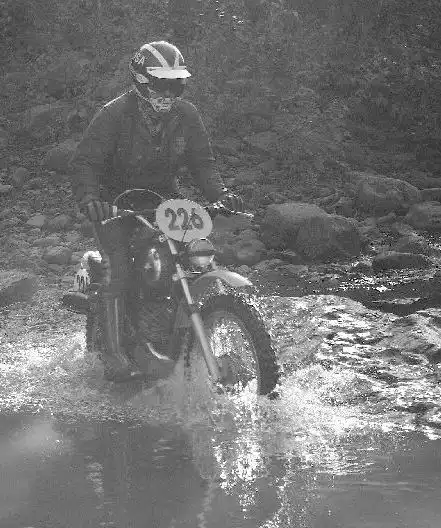
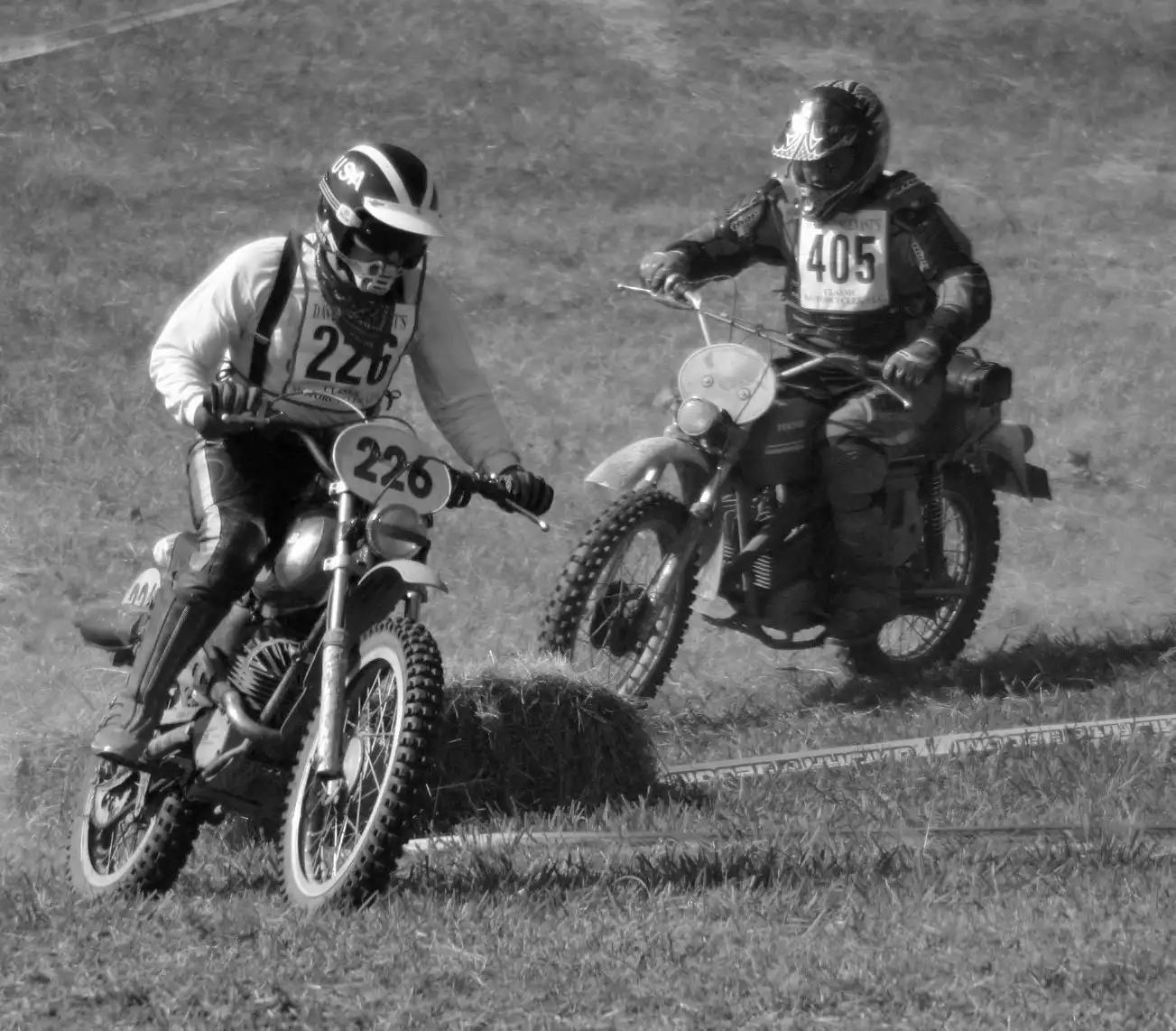
Like all of us, Dwight is feeling some aches and pains these days and injuries from over the years have begun to catch up with him. He has the bad knee, issues with the rotator cuffs in his shoulders, and has had surgery on his back as well as some work done to repair a nerve in his neck. However, you wouldn’t know it by the way the man still rides. And so, look for Dwight at this year’s ISDT Reunion Ride. You’ll never know what bike he may turn out on, but just look for one of the really fast guys, sporting an American ISDT helmet, and who talks with an unmistakable southern twang.
by Ed Youngblood
Originally printed in the 2006 issue #33 of Still….Keeping Track

Dave Mungenast was a man of many parts who seemed to earn success at everything he tried. Though he built a business empire in automobile sales and commercial real estate, his first love was motorcycling, and it remained the activity where he maintained his dearest friendships even as he expanded his involvement in other spheres of business. Only now, following his untimely death, is it becoming understood just how much Mungenast achieved as a pioneering motorcycle dealer, a world-class endurance rider, a motion picture stuntman, in automobile sales and commercial real estate, and as a philanthropist who generously supported many national and St. Louis-area nonprofit organizations. His friends and colleagues in one area of his life often knew little or nothing about his activities in another, not because he was secretive, but because he was a deeply modest man who always focused his conversations on the interests and achievements of others rather than himself. Within the greater arc that was Dave Mungenast’s life, the Penton motorcycle might be mistaken for only a footnote. It was one among many brands he rode and sold, and in the nine times he rode the ISDT, only a third of those were aboard Pentons. However, the amount of time he spent in the saddle of a Penton does not tell the whole story. Far more important than his involvement with the brand was his friendship with John Penton that, over the years, became a kind of brotherly love that the most fortunate of us can achieve only a few times in our lives.
Dave Mungenast was born on October 1, 1934 in South St. Louis, an area that had been populated during the 19th century by educated and industrious Germans. High achievement was modeled throughout his family history, including an ancestor who had been one of the master builders of Gothic cathedrals in Europe, and his own father who became a co-founder of the Junior Chamber of Commerce in October 1915. Dave was the fifth among six children, and all of his older brothers earned honors in school, and some went on to achieve distinction in World War II and subsequently in their business careers. To the contrary, Dave earned a reputation as the black sheep of the family, getting expelled from several schools and helping found a motorcycle gang that he and his buddies called “The Dirty Dozen.” Years later, one of them would say, joking, “I think there were seven of us.” Dave’s first motorcycle was a used 1946 Indian Chief that never made it home because he wrecked it along the way, and his first new motorcycle was a 1954 BSA Gold Star. As bleak as his future may have looked to his parents at this time, it was motorcycling where Mungenast found an interest on which he could focus his energy and entrepreneurial talents. Working at Bob Schultz’s shop, he became a skilled mechanic and learned sound business practices, and his preference for off-road motorcycling taught the skills that would eventually earn him notoriety as a world-class rider and Hollywood stuntman.
Dave met Barbara McAboy at Mary Ann’s Ice Cream Parlor, the local teen hangout, in 1953, the same year that he and his off-road motorcycling buddies formed the Midwest Enduro Team. He and Barbara dated for a while, but his half-hearted efforts at St. Louis University were going nowhere and he dropped out to join the Army, signing up for Airborne and the Special Forces, not because he was gung-ho but because it gave him a higher pay grade. In the Special Forces, the previously shiftless Mungenast learned of his inherent leadership ability and gained confidence in his physical skills. In addition to Airborne he became an underwater demolition expert and was later sent to Korea where he was selected as a member of the elite Honor Guard. Dave Larsen, his lifelong friend and employee, says, “In the service, Dave learned how to focus. He returned to St. Louis a different man.” It is likely that being a Green Beret was not the only factor that changed his life, because upon coming home he began to see Barbara again, and married her in January 1959. On April 1, 1960, David, Jr. was born. In addition to being a new father, Dave, Sr. was holding down two jobs and completing a degree at St. Louis University. It was as if Mungenast had made a commitment to leave behind his teenage rebellion to become a good husband and father, building on what he had learned about his character and inherent skills through service in the Army.
One of Mungenast’s two jobs was back at Bob Schultz’s motorcycle dealership. The postwar American motorcycle sales boom had begun, and when Schultz opened a second shop, Dave became general manager of the original store while still performing his duties as a mechanic. Honda had just come on the scene, and Dave was quite impressed with its design and quality. In 1964 Dave won a 24- hour national championship marathon at Riverdale Raceway near St. Louis aboard a Honda scrambler, giving the brand its first national championship in America. He won the event again in 1966. Dave felt there was a great future in motorcycling, and Schultz thought there was a great future in Dave. Schultz tried to get Mungenast to come into the business as a 50/50 partner, but the young father could not come close to the price of buying in. He told Schultz, “I can’t raise that kind of money. I could probably get my own Honda franchise for less than that.” Schultz encouraged him to take this course with his blessings, and in January 1965 Mungenast opened his new Honda store in a small storefront on Gravois Road in South St. Louis. Dave Larsen recalls, “We would uncrate and prep motorcycles late into the night, and by close of business the next day they were all gone.” With success seeming to come easy, by the end of 1965 Mungenast acquired a Triumph franchise to expand his product line. He and Bob Schultz remained fast friends for the rest of Dave’s life.
But things changed as the war in Vietnam heated up. Credit to buy a motorcycle became impossible for any young man with a 1-A draft status, and Dave’s business began to go sour. The Mungenasts now had two young sons (Ray was born in July 1961) and Dave had expanded into automobiles, taking on a Toyota franchise in 1966 before the downturn had begun. Despite the good reputation Honda and other Japanese brands had established with their motorcycles, Americans still did not think much of little Japanese cars, and it became a struggle for Dave to keep his business going and provide for his family. Still, in these difficult days, Mungenast found the time to pursue his personal passion for offroad riding. Edison Dye and John Penton had become Husqvarna distributors, and Mungenast added Husqvarna to his product line. John Penton had met Dave at national enduros, and he recommended to Dye that Dave become a member of a team they were forming for the ISDT that would be held in Poland later that year. Suddenly, Mungenast found himself among America’s greatest off-road riders – John Penton, Leroy Winters, Malcolm Smith, Bud Ekins – and in world class competition. Like any new and unseasoned IDST rider, Dave was over-excited and tried too hard. Smith recalls, “I followed him, and I have never seen anyone crash so many times and still finish.” And astonishingly, riding a Husky that looked like it had been put through a crusher by the final day, Mungenast won a gold medal. He was hooked on the Six Days and set a personal goal of riding ten in succession.
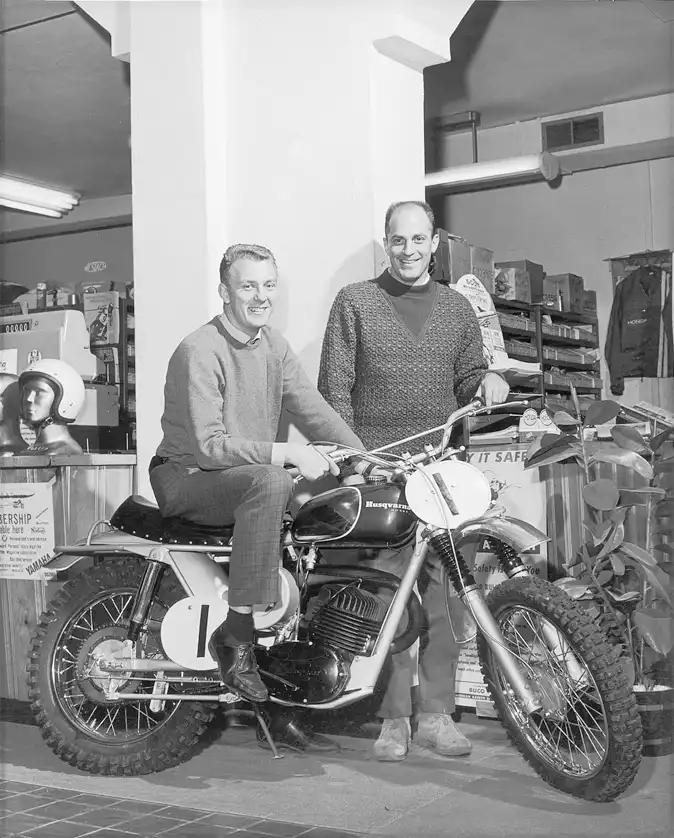
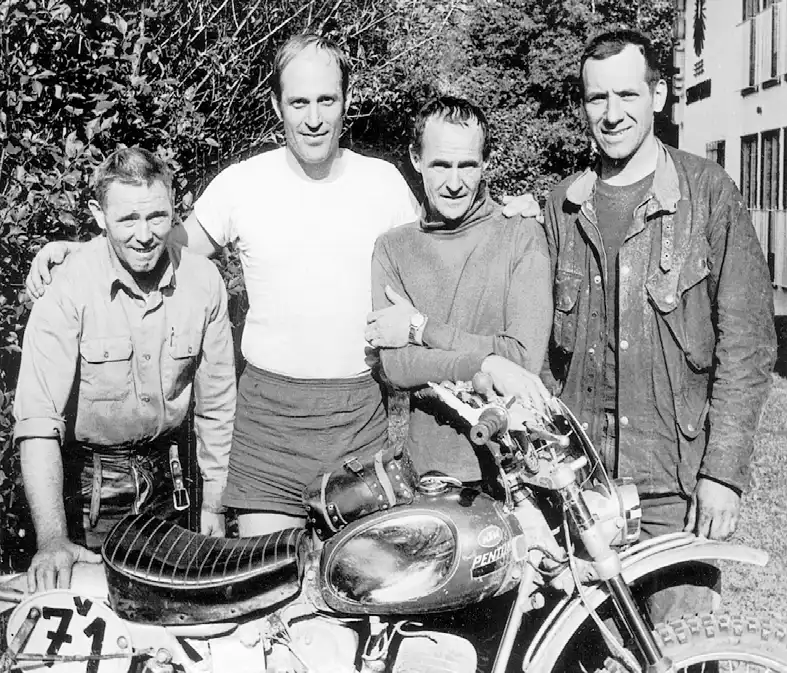
Early in 1968 John Penton introduced his namesake motorcycle, and later that year Dave Mungenast was invited to ride a Penton-sponsored U.S. Vase Team along with John, Leroy Winters, and Bud Green. It may have taught him about beginners luck, because this time he did not earn a gold medal, nor a silver. Still, he finished the event to earn a bronze, which is no mean feat. Riding that year created considerable stress in the Mungenast household because Barbara was pregnant with their third son Kurt, and she was due while Dave was away. But, thankfully, Kurt decided to be late and was not born until Dave returned home. Twice more Dave would ride a Penton at the ISDT, in 1969 in Germany and in 1971 at the Isle of Man. In 1970 in Spain he switched to Husky, which did not bring him luck. It was his first time to fail to finish due to a disastrous crash where he knocked himself unconscious and broke several ribs. For his last two Penton rides he earned silver in 1969 and gold in 1971. Mungenast would ride the ISDT four more times. A factory Honda ride brought his second DNF in Czechoslovakia in 1972, he rode a Triumph to silver medal in the United States in 1973, then for Rokon in 1974 and 1975. In Camerino, Italy in 1974 he earned bronze and at the Isle of Man in 1975 he failed to finish due to injury. There are several stories which prove that Dave Mungenast – just like John Penton – was a true-grit, never-say-die endurance rider. In 1969 Dave separated his shoulder on the first day at the Jack Pine, on the eve of leaving for the ISDT in Germany. A friend took him to the hospital, then said, “Well, I guess we can head back to St. Louis.” Dave said, “No, I have to ride tomorrow, and no one can tell John. If he learns I’m hurt, he might cut me from the team.” During qualifying in 1974, Mungenast broke his hip. Still, he made the team and rode his Rokon to a bronze medal that year. Also, he may be the only man to have won his class at the Jack Pine with a broken leg!
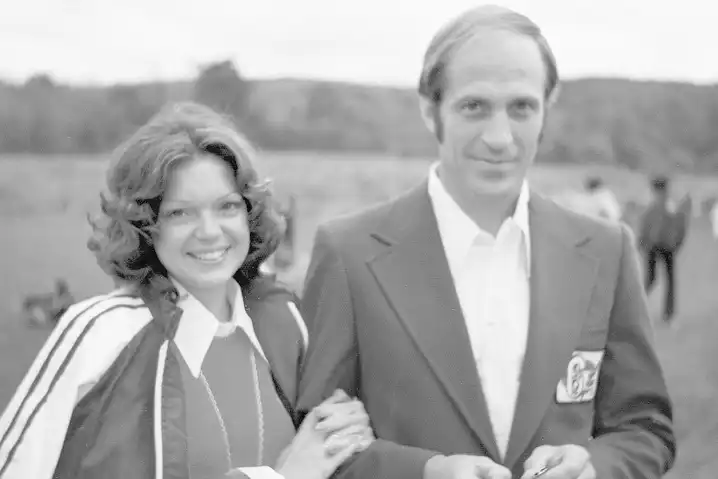

Mungenast never fulfilled his ambition to ride ten ISDTs in succession. In 1976 he failed to qualify for the American team. He probably could have gotten a ride through Canada or Mexico, but he had opened a new Honda automobile store in 1974, and the businesses were still struggling. Later he would see it as providential that he did not ride the 1976 ISDT. He explains, “Otherwise, I would not have been home to take that phone call.” The phone call he was talking about was from an old friend, Stan Barrett, who was pursuing a career in Hollywood. Barrett recruited Dave to do stunt work for several Burt Reynolds movies, including “The End,” “Hooper,” and “Cannonball Run.” Over the next eight years he would also work in “Airport 77,” “Stormin’ Home,” “Harry and Son,” and “Welcome to Paradise” where he and two other riders jumped their motorcycles off of a pier into the ocean. He described the stunt, which earned a nomination for Stunt Man of the Year, as the most frightening thing he had ever done in his life. As a stuntman, Dave got to work with Paul Newman, Jackie Chan, Christopher Lee, Jack Lemmon, and many other stars in addition to Burt Reynolds, and it turned him into a bit of a local hero in St. Louis. The radio and newspaper interviews that resulted from this work put his name in front of the public, and by the time Mungenast’s career in the movies came to an end, his businesses were beginning to turn the corner. His Honda store had become so successful that the company chose Dave as one of only 50 dealers in the nation to open an Acura dealership when the new brand was introduced in 1984. Subsequently, he opened a Lexus dealership in St. Louis and acquired a Toyota/Dodge dealership in Alton, Illinois. Over the years, he developed such a reputation for fair dealing and customer service that his stores almost never advertise. Rather, they rely on word-of-mouth from satisfied customers. Dave, Jr. explains, “today, the only time we do any conventional advertising is when one of the OEMs offers a co-op promotion so good that we would be foolish to turn it down.”
As the three Mungenast sons – Dave, Jr., Ray, and Kurt – matured and took over the day-to-day management of the dealerships, Dave and Barbara began to find more time to devote to philanthropy and community service. They created the Dave and Barbara Mungenast Foundation through which they have supported many charitable organizations. Also, Dave devoted his time and experience to service on the boards of the Motorcycle Hall of Fame Museum, the Wheels Through Time Museum, St. Anthony’s Medical Center, and other non-profit organizations. They have been big supporters in both time and money to the Boys’ Club of St. Louis, the YM/YWCA of South St. Louis, and Marygrove, a Catholic organization that helps young people at risk. He has also been chairman of the American International Automobile Dealers Association. Through these activities, the Mungenasts have met with many government leaders, including three presidents: Ronald Reagan, George H.W. Bush, and Bill Clinton.
Many early Honda dealers who got their start with motorcycles then got wealthy selling cars began to behave as if they were too important to mess with the “lower class” business of motorcycling. This was never the case with Dave Mungenast, and he proved his dedication to motorcycling when in 2000 he opened Classic Motorcycles LLC, a free-admission museum in the very store front on Gravois Road where he had his first automobile dealership. Over the years he had accumulated an impressive collection of rare and beautiful vintage motorcycles, and these have been placed on display along with the collections of other enthusiasts. For example, Bob Andersohn’s amazing collection of steel tank Pentons can be viewed at Classic. The facility often opens its doors to special events, including gatherings for motorcycle clubs. It is under the management of Dave Larsen, who joined the Mungenast organization as its first employee in late 1964.
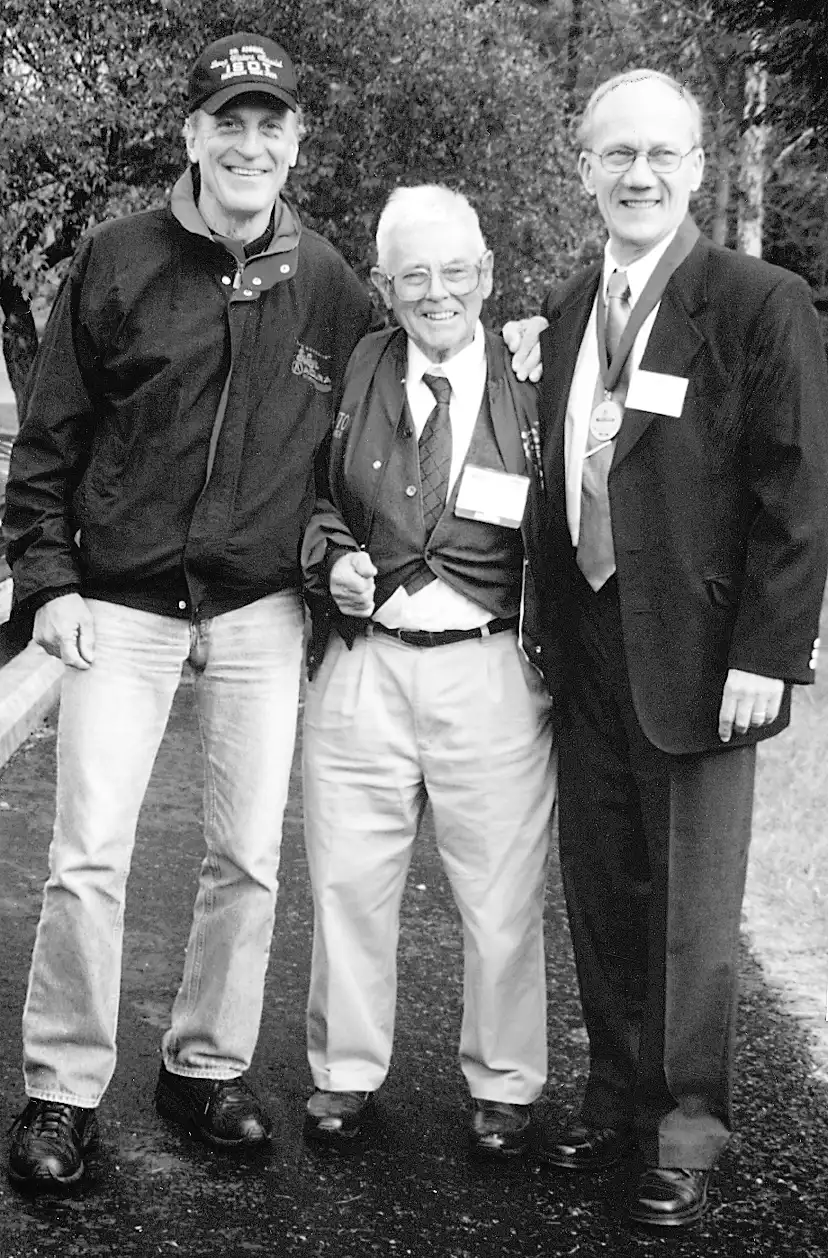
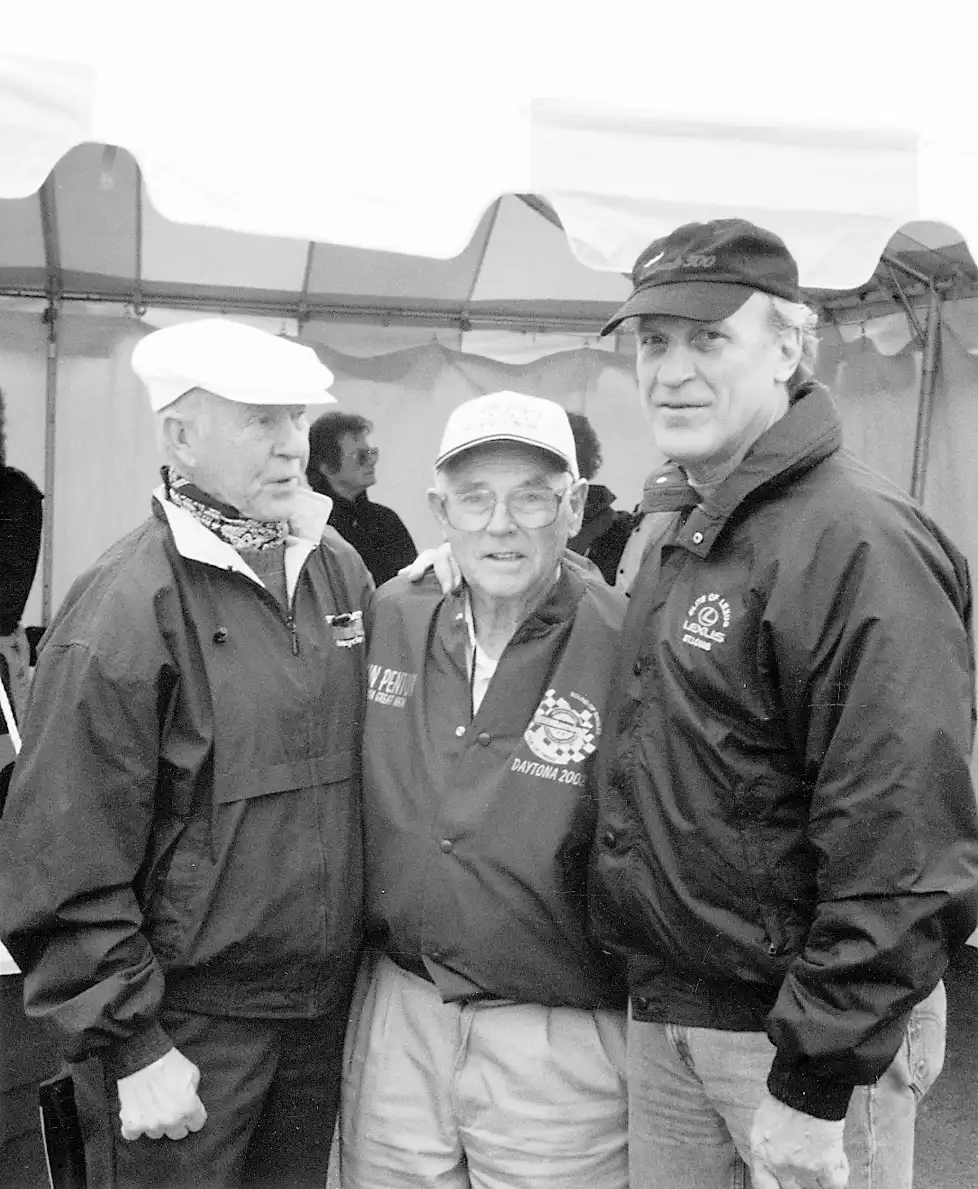
Those who were close to Dave Mungenast understand that yet another chapter of his life was only beginning. With the boys and veteran employees keeping the businesses humming, Dave and Barbara were beginning to enjoy the fruits of their lifetime of work. They had acquired large tracts of land in rural Missouri. On one they had built a retirement home where they raised horses, bison, llamas, and cattle, and hosted their thirteen grandchildren to visit and ride ATVs with Dave. On the other – near Branson – Dave had big plans to restore the old town of Garber as a historical and cultural center. He had other plans for holdings near the Mungenast marina at Lake of the Ozarks. Barbara had been developing her career as a fine artist for many years, and had begun what will be her masterpiece, a larger-than-life patriotic bronze monument that will be displayed at Fort Myer, Virginia. And Dave was finding time to continue his love of off-road motorcycling, riding the Colorado 500, Malcolm Smith’s Baja Ride, and other charity events. By all appearances, it seemed that this man who had accomplished enough for several lifetimes would easily put another ten to fifteen years into his grand plans. Speaking of Dave’s physical fitness, less than a year ago Malcolm Smith said, “At 72, Dave is a man who rides a motorcycle like a good 50-year-old.”
Tragically, early in 2006 Dave began to experience some unusual memory loss and weakness on the left side of his body. But it was with Barbara where the crisis began when on April 26 she had a heart attack. With St. Anthony’s medical center only a few miles from their home, Barbara drove herself to the emergency room, demonstrating the self-reliance she had learned during the years when Dave was away so much pursuing his business and motorcycling careers. It was a mild attack, and the prognosis was hopeful, but three days later additional bad news arrived. Dave had been checked out for his recent symptoms, and on April 29 he was diagnosed with brain cancer. Thereafter, his decline was swift, and in July he was admitted to hospice. Dave died on September 20, 2006, leaving his family, friends, and more than 450 employees still stunned in disbelief. For a period of time during his illness, Dave and the family would accept no visitors. With the typical attitude of a great endurance champion, he was determined to win, choosing to focus all his energy and concentration on the fight. But when he accepted that he would not recover, Dave turned his attention to the friendships that had meant so much to him. John Penton was one of the first people he asked to see, and among the others were Malcolm Smith, John Sawazhki, and other great motorcycling friends.

In 1975, the year when Dave competed in his last ISDT, the Eagles released their hit song “Take it to the Limit.” It became his favorite song, and its title seems to embody the attitude with which he approached every aspect of his life. Whether it was endurance riding, stunt work in the movies, or big risks in business, Dave Mungenast took it to the limit, always doing his best to excel in whatever he did. A biography about his life has just been published and is entitled, “Take it to the Limit: The Dave Mungenast Way.”
Bikes
Dave Mungenast's son Ray founded the Classic Bike Headquarters motorcycle museum in Villa Ridge, MO which includes Penton motorcycles. More info at https://classicbikehq.com/
The Mungenast family also has Pentons on display at their dealerships in St. Louis, MO. More info at https://www.mungenastmotorsports.com/
Member Profile
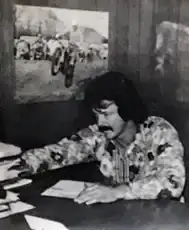
I was born in Auburn, CA. and was raised in Loomis, CA.on a 40 acre fruit ranch. I have four brothers, Richard, Edward (deceased), Frank, and Donald and two sisters, Linda and Donna.
At 7 or 8 years old, I was driving vehicles on the ranch. We had an orchard truck, which was a Ford model A flat bed truck, a farm tractor, and caterpillar tractors. I would work tilling fields, cultivation, and digging ditches around trees. The trees were irrigated and the ditching was important in getting the water to each tree. We grew peaches, plumbs and pears.
At the age of 15, I was working one of the local farms making wooden crates (400 to 500 a day), I would dump the fruit on the conveyor belt and the women workers would pick though the fruit and pack them into baskets. The baskets would then be put into the wooden crates. I would load the boxes onto a flat bed truck and take them to the fruit shed in Loomis for transport by rail.
My first motorcycle was a 1947 Cushman Eagle – I couldn't keep it running. That was around 1953. It had a 2 speed shift on the side. I paid for it from the money I earned working the ranch and neighbor's farms. I was 12 years old at the time. I would drive it all over the place when I could get it running.
I graduated from high school in 1959 and I was working for my uncle in construction building homes for about year and half. I got married in 1960 to Joyce. We had 5 children, all girls, Roxanne, Julie, Carrie, Kimberly, and Marcey.
After working the construction job, I went to work at Aerojet, a manufacturer of rocket engines. I started out doing plating and chroming, then later I became an inspector for the rocket engines using magaflux and die penetrant – checking for cracks. I worked there for about 4 years, then Aerojet had a massive layoff, and I was let go.
In 1964 I got divorced and joined the merchant marines where I traveled to the orient, South America, and Alaska, on an oil tanker. It was very hard work. I would go out for 3 months, come back 3 months and then pick another ship. Over time you would build up seniority. I did this from 1966 to 1969. While home on leave I would race motorcycles. It was one of the best things that I did in my life. I was very good at racing as long as I didn't fall off, however working on the ships for 3 months slowed up my racing career.
The local motorcycle shop in Loomis was Genes automotive Suzuki. He opened this shop in 1961 strictly for automotive repair. In 1964 he became a Suzuki dealer. He was one of the earliest Suzuki dealers in California. Lars Larson set him up as a Husqvarna dealer in 1967 and then Pentons. I hung out there all the time. My first real bike was a brand new 1965 Hodaka Ace 100. I stripped off all the lights and made it into a race bike. I raced all the races 2 times a week – mainly TTs and rough scrambles. I rode for a couple of years until 1967 when I started riding a Husky 250s in TTs, rough scrambles and then MX. I was a shop-sponsored rider for Gene. Bill Onga was Gene's chief mechanic, who won the 1969 Elsinore Grand Prix. So, Gene was a good rider and an excellent mechanic. Gene and Bill prepared the bikes and I rode them. Gene and I were good “mud runners”. I purchased my motorcycle at their cost and they would prepare it. Sometimes they would have a different bike for me to race. I raced mostly Huskys until the Penton motorcycles arrived.
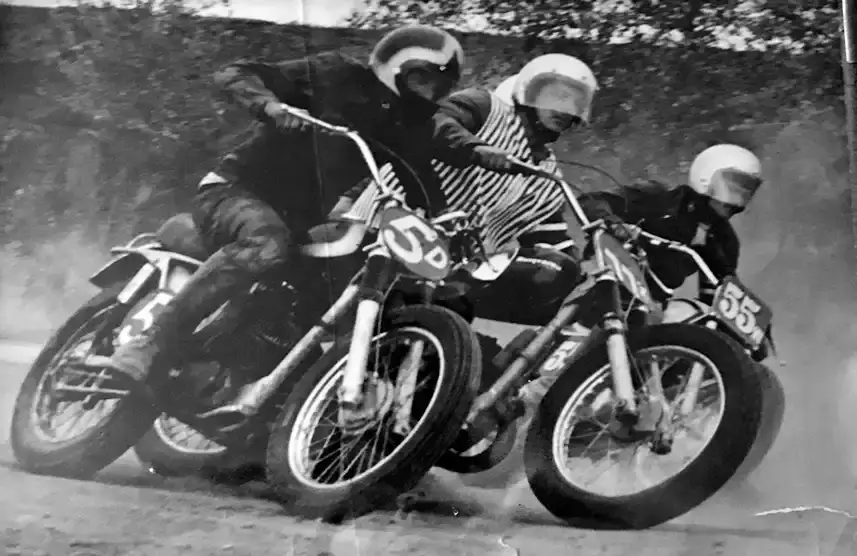
In 1967 I was one of the 12 founding members of the Dirt Diggers M/C club in Northern CA. The club is still going on today. I went to the 49th consecutive national Hangtown MX this year. We put on the first Hangtown MX race in January 1969. We had all the top riders, Gary Bailey, Dick Mann, John DeSoto, Ronnie Nelson and others. We offered a larger purse than what the AMA would offer for their nationals, so we went outlaw. This was a big money looser for the club as it rained (really bad weather) and we had to pull all the spectators cars out of the mud after the race. We made up for the loss later in the year where there was better weather and a much bigger crowd. Next year will be the 50th anniversary of the Hang Town race.
Before the Penton motorcycle, I worked for Aragon Distributing in Monrovia, CA. They sold motorcycle accessories and I worked as a salesman for them. My sales area was from Reno, Nevada to San Jose, CA. I worked there from late 1968 to early 70. During this time period my leg got busted by Donnie Emler, the owner of FMF Racing at Mammouth Mountain MX track. (Donnie built motorcycles and was a great tuner which led him to building exhausts). I was riding my Penton leading the pack and I fell in an off camber turn. Donnie was on an American Eagle and ran over my leg while I was picking my bike up. This put my racing on hold until I healed up. I still did my work at Aragon during the time it took my leg to heal. That was one of the many bones that I had broken during my racing career. Back in those early years, there was very little protective gear to wear for racing.
Lars set Gene up with the Penton franchise (in 69). They then provided Penton 125 steel tank Pentons for me to ride.
Lars handled the NW distribution of Pentons out of El Cojone for Torson Hallman Racing (now called THOR) for a short time until they they decided that they only wanted to sell clothing to the dealers. The distribution of the Penton motorcycles was then picked up by Fred Moxley some time in 1969, located in Medford, Oregon.
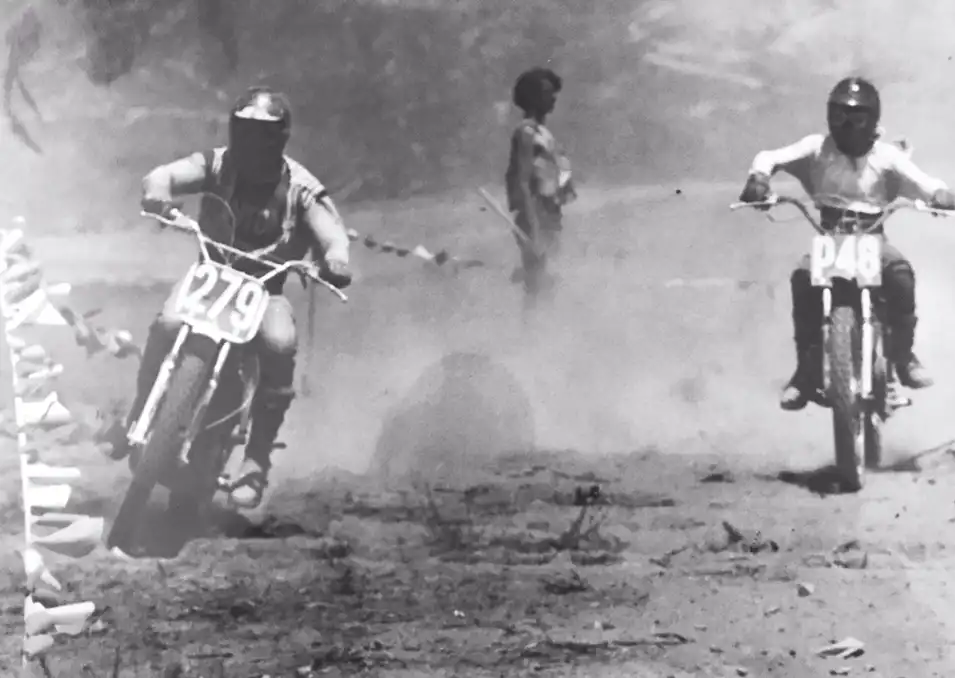
In 1970 Fred Moxley brought Penton motorcycles from Medford, Oregon to Sacramento for west coast distribution in California, Washington, Oregon, Alaska, Nevada, and Montana, This led to a better ride for me, for I was now sponsored by Fred Moxley. I received no money, just a new bike to race. I won a lot of trophies. I rode for fun and got to go to a lot of places to race MX, enduros, cross country, and desert races. There were a lot of desert races in Nevada that I went to. I shied away from MX races because you mostly waited around for your class to race. In desert racing you rode for 3 or more hours straight. I rode a lot of desert races and enduros. I began to like riding most of the day and not waiting. Even though I was still riding Pentons, I also rode Puch 125s.
There were 2 different distributors for Puchs on the West Coast – Ted Lapadakis and John Penton for a brief time. In 1972 or 73 I was working for John Penton selling Puch 125 & 175s. They were good and fast and I set up a lot of dealers with them. There was a war going on with them (Puchs) here because of the 2 distributors. Ted Lapadakis was both Puchs and DKW distributor on the West Coast in Southern Cal. DKW was Penton's biggest competitor on the West Coast.
In 1970. I was hired by Fred Moxley as a parts warehouse manager. I was then put on the road as a Penton rep for the West Coast, setting up new dealers and servicing existing dealers. In 1973 I was brought in as assistant manager for the warehouse. Fred taught me the whole business.
The warehouse was stocked mostly with just parts and accessories. There were rarely any Penton motorcycles in stock. The bikes were sent from back east to the trucking companies in containers. Fred and I would then go to the trucking company, open the containers and then put shipping labels on the crated bikes for shipment to the dealers. West Coast Dealers were always complaining because they could not get enough Pentons to sell especially the 125s. When the 250s came out we had some of those initially stocked in the warehouse.
We had Wassel Mudlarks to try and sell on the west coast. We had trouble selling them here just as John had trouble selling them back east. We would set up new dealers with the “package deal”. John did not load us up with them. We had no more than 40 or 50 and this allowed us to get rid of all of them pretty fast.
I first met Carl Cranke at 3 Sar Raceway in the Sacramento neighborhood where we raced dirt track. Carl was sponsored by Marion Pyle (called the “Big O”) Orangevale Motorcycle Center in Orangevale, CA. I was a novice and Carl was working his way up to becoming an expert. We would see each other at all the races. Because of Carl's reputation as an excellent mechanic and go fast racer, Fred hired Carl in 1971. Carl wrote technical manuals and would troubleshoot problems for dealers. He had a whole service shop set up for this. We took good care of all the west coast Penton dealers. It was Fred who recommended Carl to JP to consider him for become a Six Day rider.
In 1974 my life changed when I got custody of my kids. This was also the same time when the deal was made to turn over distribution of the Penton motorcycles in CA. to KTM.
Fred decided to leave and he opened a Mexican restaurant in Oregon. Fred mentioned me to John Penton to take over the warehouse operation (in Sacramento) for Hi-Point products. There were no more Penton Motorcycles to be sold on the west coast, they became KTM motorcycles. The distribution of the KTM motorcycles and parts was taken over by Ted Lapadais at his warehouse. This was a confusing time period. At the races there would be bikes branded with KTM and some with Penton. Some racers would remove the KTM decals and put Penton decals on their bikes. Other racers would remove the Penton decals and replace them with the KTM decals.
I had the opportunity to attend nine ISDT events as a support rider and working the check points for the Penton Six Day riders. John paid for all my travel expenses to these events. KTM would supply a bike for me to ride. The reason I was able to go to all of these Six Days events was because of my Sales manager Bruce Young. He was my right hand man. He would run the business for me during the 3 weeks that I would be gone.
My very first Six Days event was Camerino, Italy in 1974 where I got to be with all the Penton riders, Frank Gallo, Kevin Lavoi, Jeff Hill, Danny Young, Dave Mungenast and Paul Danik. I had a ball and so much fun at all of them. Previous to the 1974 event, I rode ISDT qualifying events in McMinnville, OR and Bad Rock, OR.
John owned a small car, I think that it was a Fiat, that he kept over in Austria and he would use it to drive around to meet with the manufacturers. I got to go to a lot of places with John in that car after the Six Days events in Europe were over.
I was with John Penton when we met the owner of HIRO. We went to lunch with the owner of HIRO when John made the deal to buy the HIRO motors.
I went to Alpinestars with John and we stayed at Santi's house. Santi did a lot of the designing of the boots himself. The boots at that time were made at his factory in Italy by a lot of women at sewing machines.
I went out to dinner a couple of times with John and Erik Trunkenpolz. Erik was a very quiet guy.
I stayed at Kalman Cseh's house once. Kalman would do the language translation for Erik Trunkenpolz and John Penton. When Kalman left KTM he became a distributor for Scott. He had a warehouse in Austria and I got to tour it.
John did all of the driving in that small car and he drove it fast. I remember us pulling into Paris one night and parking near the Eiffel Tower to get some sleep. It was all lit up and I was all excited looking up at it. I told John that I wanted to go see it in the morning and John said OK. The next morning I woke up with us traveling down the rode and I never got to see it. Traveling with John was straightforward. When we stopped for gas we would buy something to eat. If John would get tired, he would pull over off the road and take a 10 minute nap.
I was at the KTM factory several times. I took photos of the conveyor system where there would be moped and bicycle parts traveling along the assembly lines with Penton motorcycle parts. Drinking beer for lunch and on breaks by the employees was acceptable behavior over there. There were even beer vending machines in the dining hall. I find it funny that there were many times when we would open up a bike crate in California and find beer bottle caps inside.
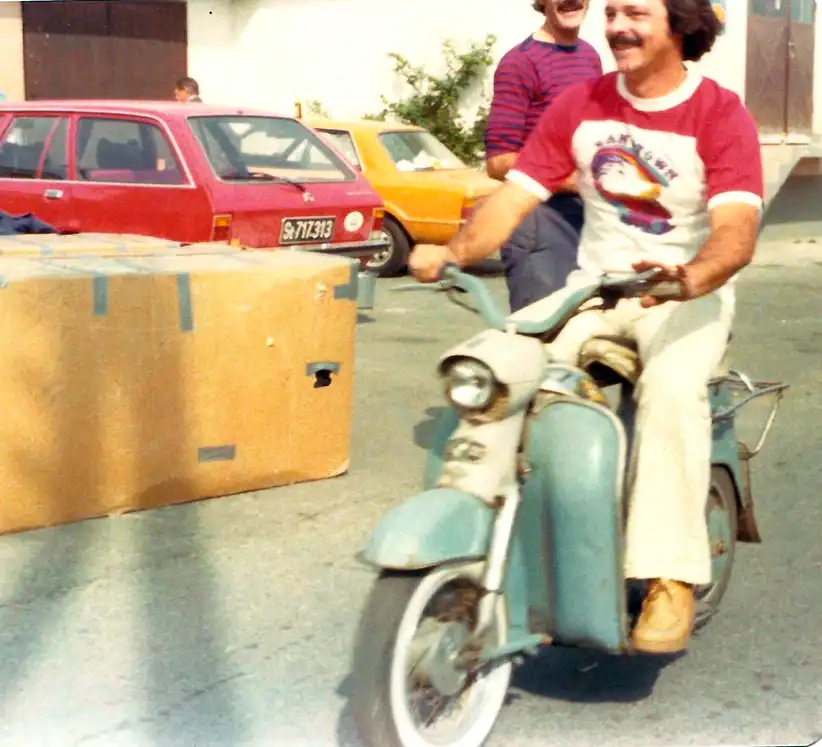
I became the General Manager for Hi-Point Racing Products when KTM took over the motorcycle distribution. We sold all the Penton/Sachs parts off to dealers in bundled deals. All the brochures, and manuals went into the dumpster. Most of the parts for the KTM powered Pentons were sent back to Texas or Ohio warehouses. There were no motorcycles in the warehouse.
No motorcycle parts or inventory were sent to KTM's new warehouse in Southern Cal. We (the West Coast operation) were officially out of the Penton business and into only the Hi-Point business.
When I took over the Hi-Point warehouse, I started making t-shirts, green and gold Penton leathers, jersies and many other items that were sold exclusively on the West Coast. The clothing lines were a good thing for us. The West Coast warehouse was in debt to Penton East (for things like rent and it's share of advertising) and we were able to pay them back what we owed them.
I would go to meetings at the Penton Lorain warehouse to meet with Larry Maiers, Matt Weisman, Elmer Towne, and other key employees to discuss what items were needed. We talked about what we were going to do and this is how many new products were added every year to the Hi-Point catalog.
When I would travel east for the meetings I stayed mostly at Matt and Barb Weisman's house. Sometimes I would stay at John's house and other times at Elmer and Kathy Towney's house.
I met Teddie Leimbach at some Six Day qualifiers and I would see him on these East Coast visits. I was at the Lorain warehouse in 1980 the day that Teddie was in the car crash with the truck. He was a very talented rider. I went to dinners at Pat and Paul Leimbach house during some of these visits also.
I had met Ted Penton back when Fred was distributing the Penton motorcycles and would also see him on my trips to Lorain, OH. He would occasionally show up at the Sacramento warehouse. He was a character. I got to see the prankster side of Ted Penton when he came over to California. We went on a tour of the ship, the Queen Mary, in Long Beach. During the tour we were escorted down into the engine room. When the tour guide continued on, Ted stayed behind and was trying to get one of the engines to start. He did manage to get some of the lights to come on before the tour guide came back and chased us out.
I remember being at a Hi-Point sales meeting in Lorain, Ohio. Larry Meiers, Matt Weisman, Elmer Towney and many Hi-Point employees were there. So here we were discussing products when John walks in. He was wearing his standard uniform, a green sweater, grey pants and mason shoes. His sweater was burnt, his eyebrows and hair were singed. The hair on his hands were also singed and he had an odd look on his face saying, “you would not believe what just happened to me.” He was at one of his properties where he had natural gas wells. He was looking down into one of the wells and lit a match. I'll leave it up to your imagination as to what happened. It is a miracle that he did not get seriously burned.
John would have an auditor come out once a year to audit our books. When I ran the warehouse I did it like I owned it. I was frugal with all my expenses with no extravagant spending.
Hi-Point Products sponsored riders like Danny Magoo, Kenny Roberts, Bob Hannah, and Ricky Graham to use Hi-Point products and show the Hi-Point logo on their clothing.
Boots were the most popular item that we sold. We could never get enough and they were back ordered all the time. The crazy thing about the boots was even though they were a big seller, there was very little profit margin in them.
Other popular items were the Hi-Point oils, jerseys pants, gloves, plastic fenders, tires, and Sun rims. We sold a lot of most of the items that were listed in the catalog. There were unique items shown in the catalog that were developed from back east, such as folding shift levers, enduro equipment, magnifying glasses (for holding a pocket watch), route sheet holders, tank bags, and tool bags. Heavy duty inter-tubes were a hot items for us. We would set up a display at the annual Long Beach dealer show to showcase the Hi-Point products.
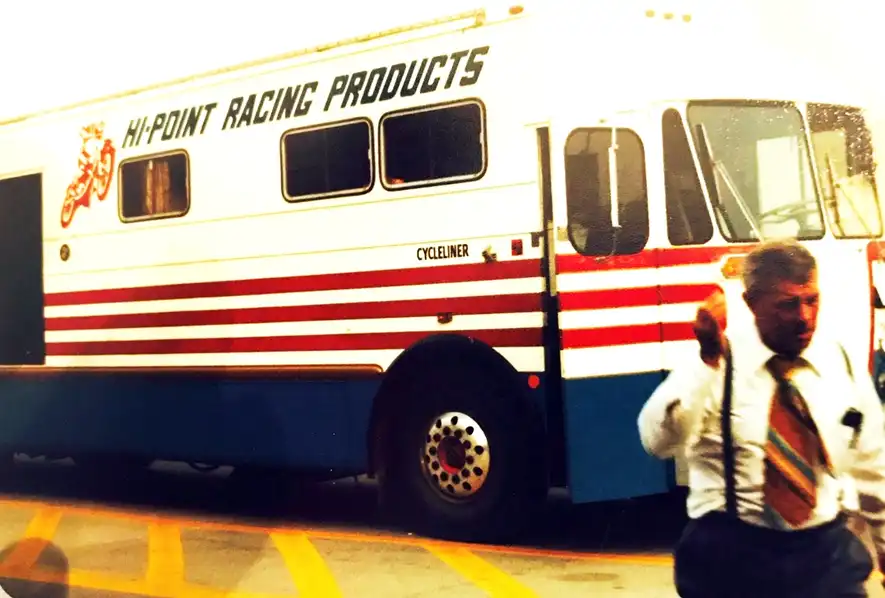
In the early 80s my partner and I built the building we were in and it was our 3rd move. The space was shared with my partner's business. Like the other two buildings, there wasn't enough room for all the new products that kept arriving, but we made it work.
When I built the warehouse. I had to build a special room to house an IBM 3200 computer. It was a huge piece of equipment that was noisy and needed to be air conditioned. I had a couple of great gals that knew how to run it. It's hard to imagine that today's cell phones are faster and have more memory and computing power than that IBM.
I knew Malcolm Smith back in 1971 when he was working at K&N. I would see him at races, qualifiers, and dealer shows. We always called Malcolm “smiley”.
In 1988 Malcolm Smith made a deal to buy the Hi-Point product line. The deal consisted of all the existing inventory except the obsolete Sachs stuff that was still around. I worked for Malcolm running the warehouse. Since I owned the building, Malcolm became my new tenant. I ran the whole business for him, buying the products and paying the bills. I would attend regular meetings in Riverside where I would meet with Malcolm and his sales team.
Malcolm had 3 key people, Wayne Cornelius, Jimmy Lewis, and Gary Drean.
Drean was the computer guru and accountant. He supplied new computers for my warehouse when Malcolm took over. Gary flew his own private plane from Riverside to Sacramento to deliver and set up the computers.
Wayne Cornelius was product manager for Malcolm Smith in Riverside. He was a smart designer. He came up with fancy gear, and got us into water sports clothing. Malcolm Smith Racing Products made a re-surge in sales because of this. We got involved with some splashy stuff with the Jet Ski craze.
Jeremy McGrath was sponsored by Malcolm under the Hi-Point name in 1988 before he got picked up by Honda. He was discovered at Mammouth Mountain MX, a ski resort in the mountains NE of LA. This is a big event held every year in June. Riders at that time, who were under motorcycle company contracts, generally were allowed to obtain clothing and gear sponsorships of their choosing.
In 1990 an Asian company (corporate raiders) made a deal with Malcolm to buy Malcolm Smith Racing Products. They took out huge loans on the business and payed themselves lavishly. Their dishonesty wound up driving Malcolm Smith Racing Products into bankruptcy. Rocky Cycles (known now as Tucker Rocky) wound up buying the business at auction. What was left of the inventory at my building was moved to the other warehouse buildings in Riverside and that was when I left.
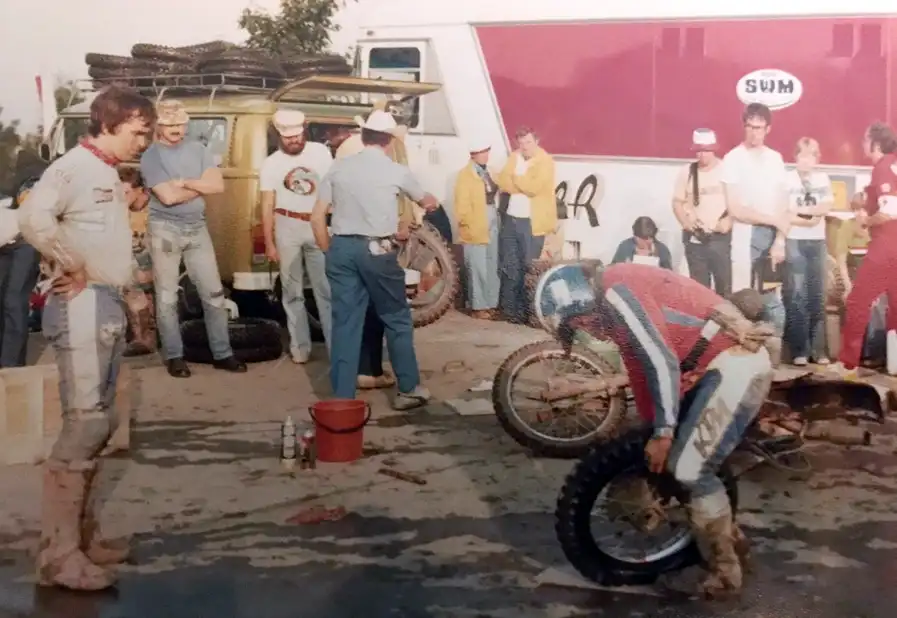
I ended up selling my half of the building to my partner. I did not do anything for a while. I worked for about a year for a friend installing car alarm systems in new cars for dealers.
I then went to work at Seafood Suppliers, Inc. a wholesale sea food business owned by Bill Dawson, who was one of the founders of the Dirt Diggers. He owned a warehouse right on the docks in San Francisco. I commuted to San Francisco for this job staying at his home during the week and traveling back to my house on the weekends (a 2 hour one way drive). His business consisted of buying fresh caught fish from the fishermen, at their boats at the docks. The fish were then taken to his warehouse where they were cleaned, filleted and packed. His customers were all distributors who sold to restaurants. For this type of work, the day generally started at 4 am. I handled the sales, talking to customers, and kept track of the inventory.
To meet our customer's needs, other varieties of fish from the East Coast and Canada were air freighted in, along with oyster and clams from Boston off Cape Cod. Air freighted shipments had to be picked up at the airport to meet our customer's requirements. This would become nerve racking when there would be flight delays.
I did this job for about 2 years. Bill was having some problems in running his business and making a profit. He was in debt and I helped to get things in order and pay off the debt. This was a fun interesting experience for me.
I then went to work with my brother, Frank in construction – mainly fire restoration. I worked in the office with him for about 2 years. It was a very successful business that was sold to our nephew. It involved mostly insurance claims. We were basically fire truck chasers. We would find out where the fires were at and go there before the fire trucks left. We dealt with home owners who were panic stricken and in a state of shock. We would explain to them what was going to happen and that their insurance company would be paying for their stay in a motel until their house was fixed up. We would then get their permission to board up the house. We would then get back to the homeowner with a price quote to fix the house back up. In most cases the insurance company would approve our quote and we would get the job. It was a dirty business, dealing with smoke damage and soot, but it was a fun business.
Up until just recently, starting in 2000, my younger brother Donald and I were buying houses, rehabbing them and then reselling them. My brother was the genius. He had years of experience as a carpenter dealing with dry rot. He could do everything, carpentry, electrical, plumping, drywall, anything and everything except carpeting and roofs. We kept some of the rehabbed properties to rent. We are now down to one last one. He had the talent and I had the money. We focused mainly on foreclosures, bank owned and condemned houses.
I became officially retired in 1999. I did all of these and other things to keep busy and make up for the retirement plan that I never had.

I found out about the Penton Owners Group from Bruce Young at Western Power Sports. I joined in 1999 (member no. 230). I think that it is pretty neat.
I was at the 2000 AMA Vintage Days event at Sears Point where Penton was the feature marque and John Penton was the Grand Marshal. That was a great time. I remember John taking the parade lap around the race track and going the wrong way. I hung around the booth talking with Matt Weisman and even helped sell T-shirts one of the days there. I remember it being a good size event. There was also a cook out at a city park one evening. That Vintage Days event was also the last time I met Jim Pomeroy.
Todd Huffman did a very good job with the making of the John Penton movie. He did an hour and a half interview with me in California and I am in the movie twice for about five seconds. When the movie came out, I went to two of the showings at the movie theaters. One was in Sacramento the other was in Placerville, which used to be called Hangtown before they changed the name. In watching the movie I learned some things about John Penton that I did not know. After traveling with him all those times and being at meetings with him I thought that I knew all about him.
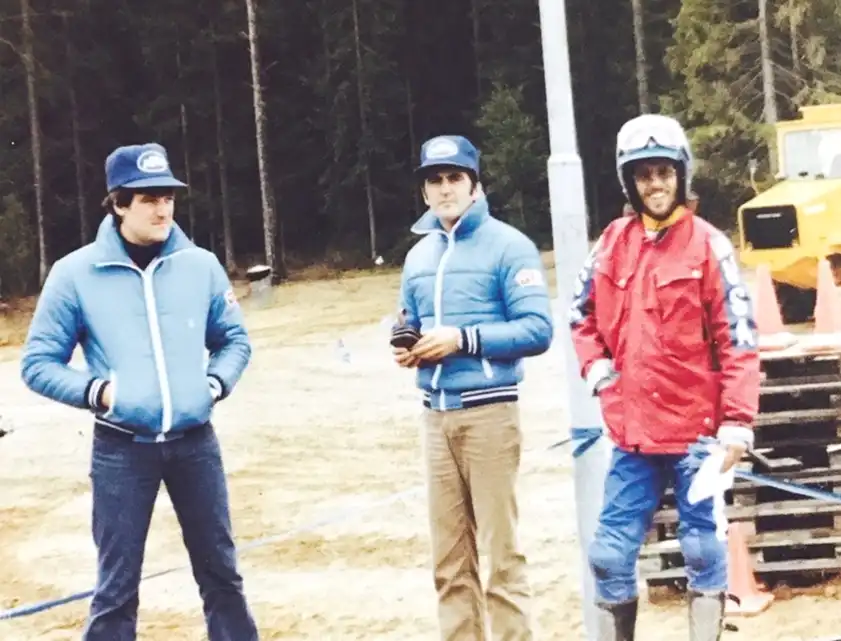
I am blessed for being involved with motorcycles, the racing and all the wonderful people that I worked for and was involved with. Without these contacts I would never have been able to travel to Europe and meet some of the people involved in the motorcycle industry. This was a great experience for me during this lifetime. I wouldn't trade these memories for anything.
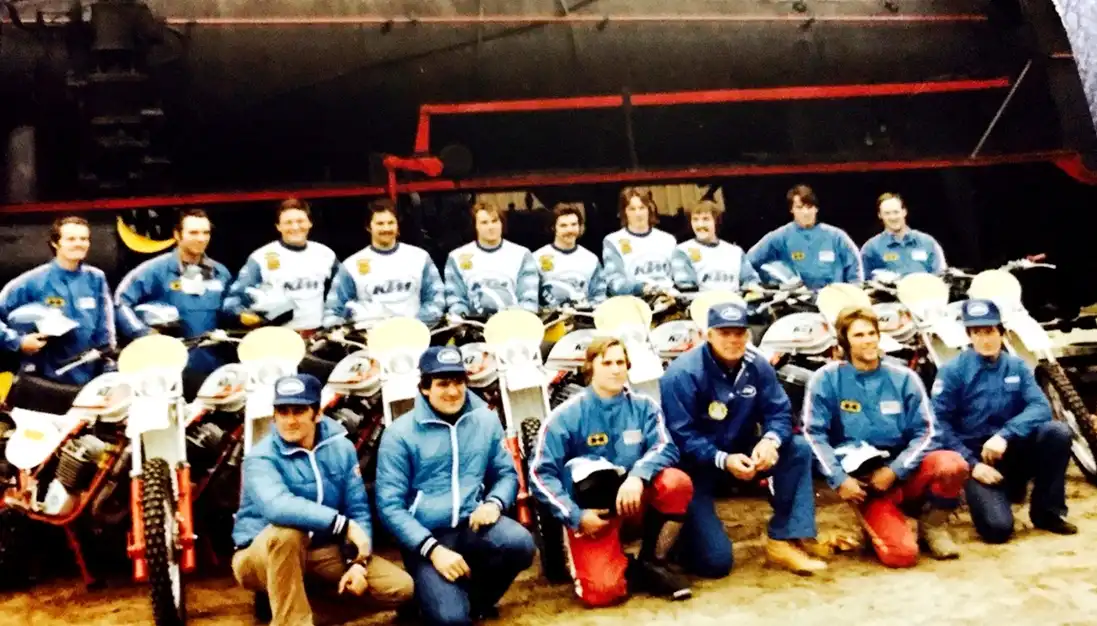
by Alan Buehner
In my conversation with Penton owners for the past several years, most people would ask about John Penton during the conversation. For some strange reason, during many conversations I would have with West Coast Penton owners the name Carl Cranke would be the first name asked about. During some of the monthly meetings, I had heard about Carl and what a talented rider he was, but I never expected him to have the following that he does. I met Carl for the first time in April at the AMA Vintage Days event at Sears Point where “Penton” was the feature marque and he took time off, away from his family to join us at the event. The following is a little background on Carl and some of the stories that he shared with us.
Carl Cranke was born in Lake Charles, Louisiana and raised in northern California. He was a quiet kind of kid while growing up but that all changed when he discovered motorcycles.
My first bike.
“While I was going to high school in 1964 there was a motorcycle shop along the way to and from school. It was Orangevale Motorcycle Shop that sold Suzuki, Triumph, Greeves and Maico motorcycles. In order to hang around the shop and get to know more about these wonderful machines I offered my services to help out in doing anything. The owner, Marion Pyle, gave me the job of cleaning the cosmoline off of the new bikes. This was coated on the bikes to protect them from the elements during shipment. No one at the shop enjoyed this chore but I eagerly jumped in to do it. It was a messy job that required using a solvent to remove all that sticky goo from the bikes, but it got me into the back part of the shop where I could see all of that things that go on with fixing, repairing, and building bikes.”
“After a few months they put together a specially tuned 50cc Suzuki for me to ride at 3 Star Raceway, the local dirt track which was a 1/10 mile oval flat track. In those days, the novice riders were lined up on the front line. As riders would show their skills by winning races, they were moved back to the next row behind the novices. The more you won, the further back you were placed for a starting position with the best riders on the back row.”
“So there I was at my first race on my very own race bike and I never told any of the guys at the bike shop that I never even rode a motorcycle before.
“At the next race I was put on the second row because of my win at the last race. This meant that I would have to pass the riders on the front row and I told Bob Taylor that I did not know how to pass and I asked him what I should do. He took me out onto the track with my bike and placed it on the outside berm. “This is where you ride your bike. Keep it wide open until you pass everyone” he told me. So, that is what I did. I put the bike on the outside cushion and rode it all the way around the track. I had a couple of tight squeezes when I passed some riders who were also riding the outside edge and I somehow managed to get between them and the fence.”
“I always rode the cushion and I did it with the throttle wide open. My bike was so fast that I won every race for the rest of the season. The more races I went to however, I did notice that the bike was becoming a little harder to control if I would let up on the throttle and I would have to make sure that it was kept wide open to prevent that small bike from bogging down. I found out later that Bob was gradually upping the gear ratio on the bike for each race I went to. This is how I learned how to race dirt tracks”
Carl, you won many dirt track races, what brand of bikes did you ride.
“I was riding Suzukis, Triumph, Bultaco, & Jawa. My favorite bike was a special Triumph Cub short tracker.I liked Bultaco for TT and scrambles.”
Where did you do your short track racing?
“I raced all over northern California and southern California. In my pro novice year, 1968, I was the HiPoint novice shorttracker in the nation.”
You competed in desert races. What brand and sizes of bikes did you ride and which was your favorite brand and size?
“My first desert race I rode a 73cc Sachs. I loved to ride Pentons later on in my career. It was great to win overall on a 125cc bike.”
You then moved into riding MX. What brand and size of bikes did you ride and which was your favorite brand and size?
“I rode motocross because I could ride three classes (125, 250, open). That was 9 20 minute motos in one day! At first I rode a DKW 125 (before Penton). In the 250 class, CZ was my favorite! In the open class I rode either a 360/380 CZ or sometimes a 400 Husky. That was a trick switching sides shifting as you rode 9 motos.”
It was Carl’s early experience with Bob Taylor, a mechanic at Orangevale Motorcycle Center, that he learned not only how to ride but how to repair motorcycles and make them go faster. Bob taught him the tricks of how to port the cylinders of motors. Carl was always known for never leaving home without his grinder. He was the master at taming the KTM 250 motors to make them more powerful and controllable.
The Penton experience
“In 1971 the West Coast Distributor was after me to ride a Bultaco at the local tracks. I did not like Bultacos and I turned him down. I had my eye on riding a Penton. I went to the local dealership and asked them to sponsor me with one of the new Pentons to race at the local MX tracks. They turned me down because they were sponsoring another rider. I was upset with being turned down and decided that I would have to prove myself by beating their Penton rider. I took advantage of the Bultaco dealer by accepting his offer to ride the Bultaco. I raced it once at the next MX race and won. I went back to the Penton dealer and they gave me a Penton to ride. That was the last time I ever rode a Bultaco.”
“In early 1972 I read about the I.S.D.T. events and had a desire to compete in it. Fred Moxley of Penton West contacted John Penton about my desire to ride the qualifiers for the upcoming ISDT event and what a talented rider I was. John had doubts about me because I was one of those California riders. John knew California riders could ride in the desert but that they did not have the skills to ride the woods, water, and mud of the Enduros in the east. Fred persisted and John agreed to meet me and check out my riding skills. When I met John for the first time, John knew that he was wasting his time and I became known as that long haired hippie from California.”
“I was given a new 175cc Puch by John to ride in the last 2 day qualifier of the season in southern Ohio. It was a nasty event with lots of mud holes. Out of 200 starters, only very few riders finished the course. I was one of them and I came in 2nd. Only two gold medals were awarded. Carl Bergen on a 250 Husky came in first and I on my 175 Puch. John was impressed (since he knew that there was no way I could finish the event let alone win, riding that bike) and he gave me a place on the 1972 Trophy Team. That Puch was a piece of junk. Before I rode it in the event, I pulled the motor apart and ported it out to obtain all the power I could out of it.”
Carl qualified and went to his first I.S.D.T. event in Spindleruv Mlyn, Czechoslovakia where he won a Gold medal riding the 125cc class.
Carl shared a story about his experience at the Isle of Man, England event held in 1975 during which he was riding a Penton in the 350cc class.
“1975 was the last year where on the sixth day the special test was a road race run on the city streets and riders rode their bikes equipped with knobby tires. All of the following Six Day events had their special test run on a natural terrain course and run as a MX race.”
“Jack Penton rode the special test first. I asked him how the course was. He said that it was OK and that I should have no problem taking the corners because the knobby tires would slide around the turns just like dirt track racing.”
“I grabbed the lead in my race. At the first turn I set the bike up and gassed it to slide around the turn. The bike kept sliding and I wound up going up and over the curb. Behind me were two CZ riders on their Jawas. As I jumped the curb, I remember them riding by, you know their riding style, sitting straight up even in the turns, riding side by side. As they negotiated the turn, They turned their heads to watch me hit the curb, then turn their heads back to continue on their way. When I saw them the way that they looked at me, I could sense what they were thinking (typical American rider, careless and rash with no sense of consistency). This embarrassment motivated me to turn this road race into a flat track and catch up to these guys. I pored it on and soon caught up with them at another turn in the course. They were riding side by side when I went around them on the outside, tucked in, sideways, Freddie Nix style.“
Carl was the only American rider to win that special test. He took home a Gold medal
On July 8, 2000 Carl Crank was inducted into the AMA Motorcycle Hall of Fame Museum in Pickerington, Ohio.
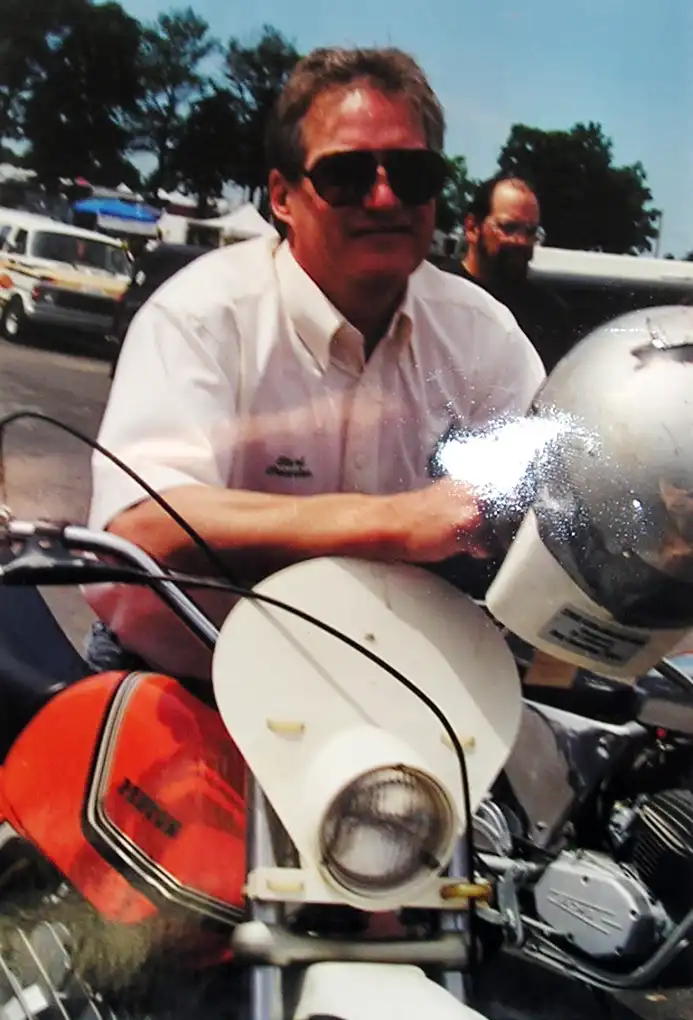
See Also
Carl Cranke Remembered: Stories From His Friends
Videos
Related Tech Tips
CARL CRANK PORTING SPECS for 100 and 125cc Sachs Cylinders
Misc
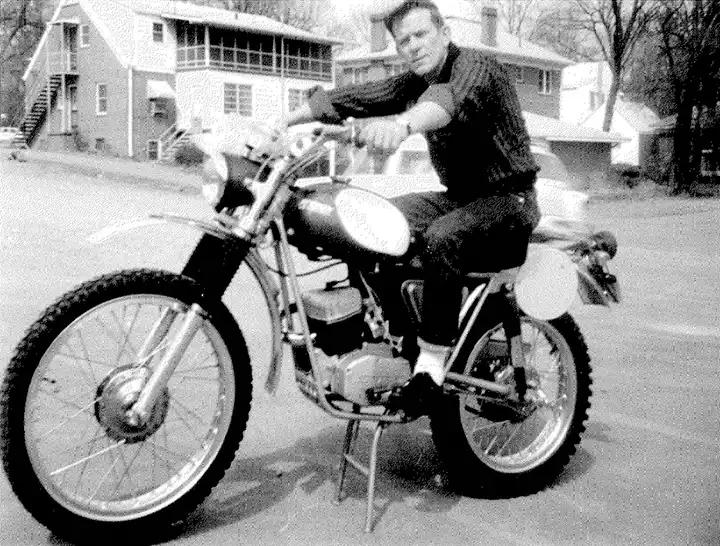
MY FIRST “REAL” MOTORCYCLE
by Al Born
Originally printed in the 2002 issue #15 of Still….Keeping Track
I received my introduction to motorized 2 wheelers in the summer of 1946 on my cousin’s new Whizzer motor bike. I was 12 and he was 13 at the time and even though this was a real genuine Whizzer with heavy duty spokes and such, my memory says that we pretty much rode it to the ground that summer. There is a lot of hills down there in West Virginia and even though that Whizzer ran pretty good, we still did a lot of pedaling, especially when we were riding double. Anyway, it was a lot of fun and I guess you could say that I “was hooked”. We rode that little Whizzer until it finally died near the end of the next summer. Then I just dreamed of owning a “real” motorcycle some day. I graduated from high school when I was only 16 years old and could not get a good paying job at that age. So, I guess you could say that I just kept on dreaming as I sure couldn’t afford a “real” motorcycle.
During the summer of 1952, one of my friends who was a couple years older than I bought a 1946 Indian. It was a large one with a 2 cylinder engine that was hard starting and very heavy. We pushed it a lot and rode it a little in some way or the other. It also damaged my cousins barbed wire fence (with her on it) and tore up about a half acre of my Dad’s corn field when it got away from my friends younger brother. In September of ‘52, my friend went into the Korean war, so the next month I came to Ohio for a better job. I went through some hot-rod Mercurys for the next 3 or 4 years, but the yearning for a “real” motorcycle never left. I finally got a good job at Ford in January of 1955, so I was soon thinking of getting my own two wheels with a motor. One day I was driving up Elyria Avenue in Lorain and there in a used car lot sat a pretty, blue, 1951 125cc Harley Davidson with a “for sale” sign on the windshield and I knew I had to have it. So, I used some of the money I was saving for my next Mercury and I became the proud owner (at least I thought) of this pretty blue Harley. Well, it just didn’t turn out to be the “jewel” that I thought it was. It had wiring/ ignition problems that I just couldn’t get all straightened out, so I spent some time pushing this “Dream Machine” too. The only good thing about that little Harley was that it pushed much easier than that old Indian that we had pushed around in those West Virginia hills. Thank goodness, fall finally came and I put that little Harley in the shed for the winter. Around February 1956, a guy at Ford that everyone called Cowboy and I were talking one day and he said that he had a 1949 45ci Harley with a 3 speed transmission that he wanted to trade for a small motorcycle. I began thinking that here was my chance to unload my pretty blue Harley. The “catch” was that his motorcycle had back-fired through the carb and caught it on fire. It had burned the wiring, seat cover and pad, rear tire as well as melting most of the paint from the gas tank. He led me to believe that I was getting a good deal, as the parts wouldn’t cost too much. So, we traded even up. I went to work and painted (by hand brushing) the gas tank while waiting for the wiring harness to come. It finally came and when I put it on, it started right away. It would start real easy when it was cold but not when it was hot. I soon discovered that the carb adjustments were warped from the fire, so I usually rode with one hand on the carb turning the adjustment screws, trying to keep it running half-way decently.
One evening Ralph Haslage came over to my house and he was riding a beautiful 650cc BSA twin. He took me for a ride and when he changed to second gear, my feet went up past his head and I knew for sure that this was a “real” motorcycle and I had to have one. The next evening Ralph and I went to Penton Brothers Motorcycle shop and they had a nice 1955 BSA 500cc twin. I talked to Elmer Reichart about trading in my Harley which he didn’t seem interested in at all. About that time John and Ike came into the shop and when Elmer told John about my Harley, he just laughed and told me that if I wanted the BSA I would have to buy it without a trade, which I did that night. That BSA became my first “REAL” motorcycle as far as I was concerned. I rode it a lot that summer and all of the next year which was 1957. Back then the motorcycle shop was open on Friday nights and a lot of guys spent their Friday evenings there talking motorcycles and drinking coffee with John, Elmer and sometime Ike and Ted would drop by as they were running the Machine Shop at that time.
In the late summer of 1957, Ralph took me to a Scrambles race at the Meadowlarks track in Amherst, Ohio. My most vivid memories of that day was seeing George Singler broad-sliding his BSA around the sharp turns while standing up. I had a problem believing what I was seeing. I remember telling Ralph while on the way home that if I could ride a motorcycle like George did that I would be the happiest guy in the world. Needless to say, George became my motorcycle hero on that day.
In the winter of 1957 and 1958, a group of us from Avon, Lorain, and Elyria organized the Avon Cycle Club which was in existence for 7 or 8 years. We rented a farm on Lunn Road in Strongsville and proceeded to build a Scramble track. One Saturday after we had finished grooming the track for our first race, the guys that had their scramblers there decided to have a little race to check out the track. I joined them with my “real” BSA street bike and to my surprise, I beat them all. My bike did have a nice set of STS tires which worked nicely on that track. Anyway, after that little deal, I knew I was hooked on racing and that there was no way out. Later on that summer, I bought a well-used 250cc Maico from Sills Motor Sales in Cleveland. My first official race was the “Buckeye Sweepstakes” at the Meadowlarks track and I was running second to Bud Ward in the feature race when my engine seized so tightly that it bent the connecting rod. I then bought a new 250cc Maico from Sills and I traded my first “real” motorcycle for a BSA 500cc B-33 model that I loved to race even though it was heavy and under-powered against the Gold Stars, Triumphs, Matchless, AJS and Velocettes. I would usually be in the top three and I even won a few times. As a matter of fact, I was able to beat my hero, George Singler a couple of times during the summer of ‘59. I know that one time it was at Alliance, Ohio, and I think the other time was at Mineral Ridge, Ohio. I know that both times I had trouble getting my “Big Head” into the truck when it was time to go home.
During the winter of 1959-60, Ray Sill who owned Sills Motor Sales told me at one of our CRA meetings that he was building a 650cc Triumph for scramble races ant that he wanted me to ride it. It sounded like a pretty big task, but my friend Bill Horton who was working for Ray at the time talked me into buying it. He knew it would be a good motorcycle as he had done some of the work on it. I traded the Maico in on it and took it home and put it in the utility room and began the chore of making it lighter. Ray had given me two “shorty” exhaust pipes for it and I put a moped gas tank on it. I used a BMW rear fender type of seat that I drilled a lot holes in the seat pan and removed most of the padding. Also, I bobbed the fenders, drilled centers out of shock bolts, axle bolts, and any other bolts of any size, and was able to get that monster down to 261 pounds. It was really fast and I geared it for 2nd gear starts which worked great for my weight. Counting heat races, semi-finals and finals, I raced that Triumph 36 times that summer and won 32 of them. I’m sure that I was into the first corner first all but five times out of those 36 starts. One of the wins was the “Buckeye Sweepstakes” race win that year at the Meadowlarks track in Amherst. The amazing thing about the Triumph was it’s dependability. My only work on it consisted of oil changes to the engine and one oil change to the forks, cleaning the air cleaner and spark plugs occasionally. It finally seized up at Norwalk as I was leading the last race of the year.
John Penton talked be into buying a used 175cc NSU that Norm Smith had traded in. He wanted me to try some Enduro riding in 1961. I believe that the NSU weighed about the same as my Triumph had. It was a rugged little motorcycle and I rode it on TT tracks and on Scramble tracks as well as a few Enduros. I was riding it at Smith Road Raceway in September of that year when I got my left leg all torn up by Tom Hodges’s rear wheel and sprocket and ended up in the hospital for a week. In December of that year, I rode a 75 mile enduro at Mansfield even though it was still difficult to walk. My NSU sheared the key in the automatic spark advance and luckily my friend Bill Horton came by. His big Matchless had started leaking gas, so we put my gas into his tank and he towed me to the next road because I certainly wasn’t able to push it. I only rode occasionally during the next four or five years thanks to Brown Warner and Bill Kennedy for letting me ride their BSA and Triumph respectively. I went through the Millwright Apprenticeship during this time and did not really have the time to do much racing due to a lot of overtime and going to school.
Then in March of 1966, John Penton talked me into buying a little Honda S-90. This was a time when Hare Scrambles was really coming into existence. We did some “trick” things (all legal) to the engine, lengthened the swing-arm 1 and 3/4 inches, stiffened the fork springs, installed some flat aluminum fenders and changed the handlebars and was ready to go. I rode mostly Hare Scrambles on it until the Pentons came out, but also did some Enduros and a few TT races (with knobbed tires). From April of 1966 until March of 1968, when the Penton come out, I was able to win my class over thirty times including a State Championship in 1967. Three times that little Honda won me overalls at Lagrange, Galion, and at Mansfield, Ohio on muddy tracks. I sold my trusty 90 to a friend at work in the summer after the Penton came out. His two teen-agers rode it for years until they broke the frame at a point where I had put a large hole for frame breathing. They kept riding it with the sagging frame until they finally collapsed the rear hub assembly. I sold the same man a Honda SL 125 in 1976 and he gave me back my little 90. IN 1981, I rebuilt that Honda with parts from a “parts bike”. The engine still ran great and does yet to this day. It was quite a reliable motorcycle, but when the Pentons came into existence it put my little trusty 90 into the antique class.
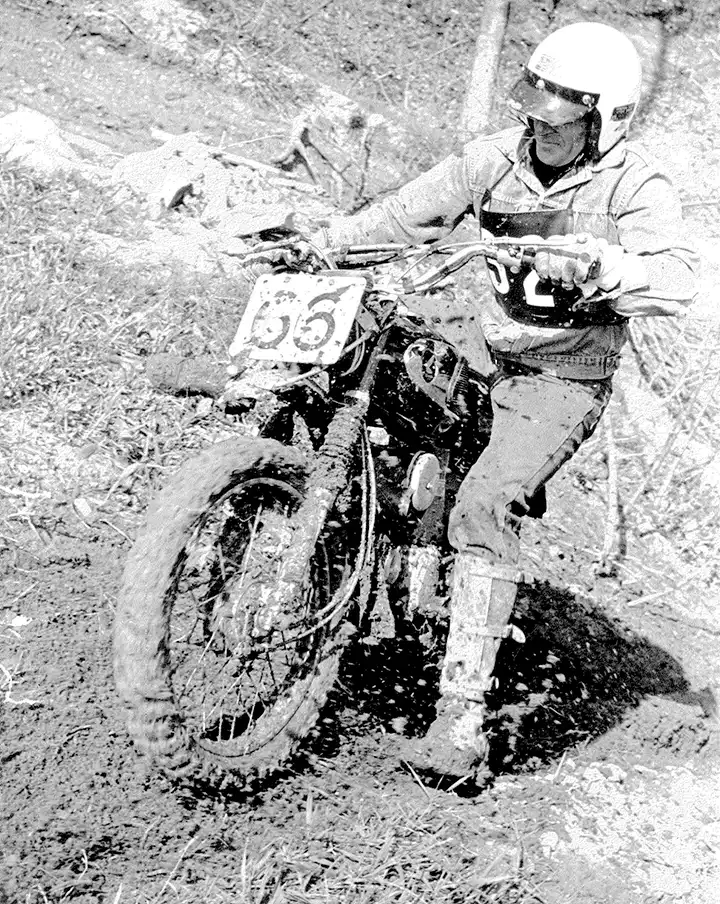
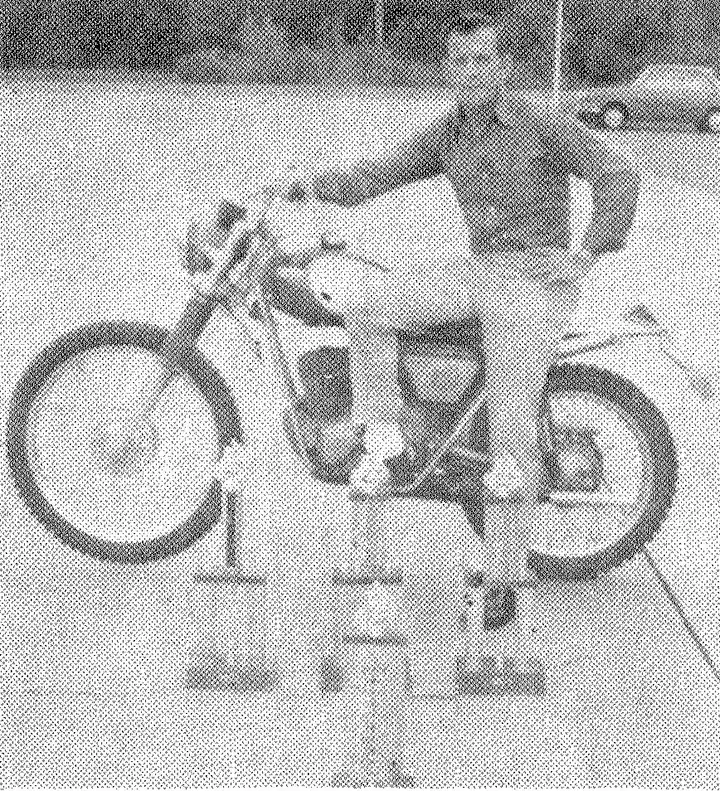
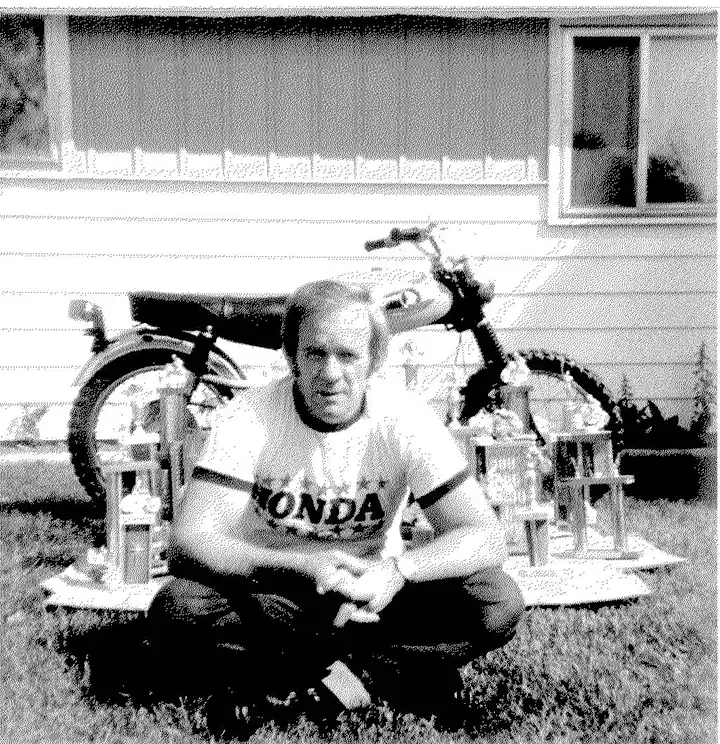
When the new Penton Six Day came out, I told John that I would wait until he made a 100cc so I could stay in the same class, but he insisted that I ride one of the 125s and he promised me that as soon as the 100cc engines were available that he would give me a new engine, which he did in August of that year. Anyway, I bought the very first Penton that was sold, its serial number being V003. I also had the honor of being on the first official Penton team which came about at the Berkshire Trials in Massachusetts. The team consisted of Leroy Winters, Tom Penton, Bud Green and myself. I guess that I didn’t realize it then, but I was riding with some high caliber people. I only got a bronze medal that year, but our team won the manufacturers award. That was the year that John Penton was the only gold medal winner on his Husky. I got to ride the Berkshire again in 1969 on the Penton team who again won the manufacturers award. This team consisted of Leroy Winters, Tom Penton, Doug Wilford, and myself. This time I was fortunate to be a gold medal winner. To this very day, I still have a feeling of pride for being on those first Penton teams and I am grateful to John for having confidence in me.
I kept riding Hare Scrambles, Moto-cross and a few TTs on that old number 3 Penton until May of 1970, when I purchased a new Berkshire 100 which I rode until the late fall of 1970 when I decided to leave it up to the younger fellows. I gave that Berkshire to my son John, who raced it up until 1976. He did a restoration on it in 2000 and he won the “Best Berkshire” award at the 2000 Vintage Days when the Penton was the featured motorcycle marque. My restored number three Penton was the featured motorcycle at Vintage Days mentioned above, thanks to the nice restoration job by Kip Kern. It is presently in the “Hall of Fame Museum” and is scheduled to be there until September of 2002. For this honor, I would like to thank John Penton, Kip Kern, Ed Youngblood and all the board members of the Penton Owners Group.
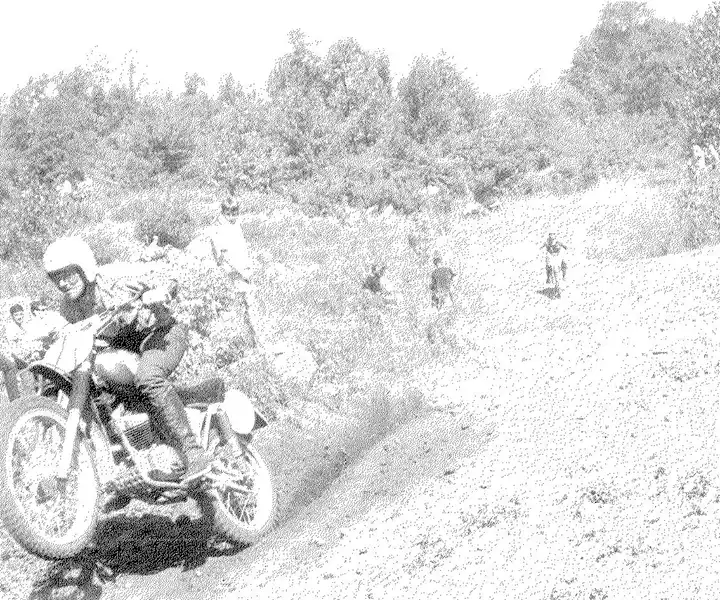
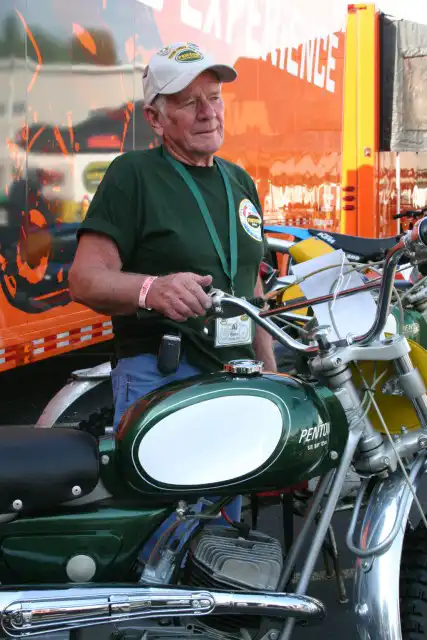
Many of you know, but some don’t, that I lived in the apartment over the Penton Brothers Machine Shop for four years (March of ‘67 thru March of ‘71). Having a nice place to work on my motorcycles, the use of the tools and especially for use of the power washer certainly made keeping my motorcycles race ready a whole lot easier, and for that I also want to “Thank” John and his family.
I used to wish that I had been born a few years later so that I could have raced the more modern motorcycles, but when I look back at everything, I just thank God for everything he allowed me to enjoy in the motorcycling world. Being a part of the Penton motorcycle development era and living at Pentonville while Tom, Jeff, and Jack were teen-agers and becoming young men were very interesting years. Sometimes I would take the boys racing when John was gone and sometimes I would sign as their guardian so they could race and guess what - they usually beat me.
Traveling with John was always an “EXPERIENCE” and I found out in 2000 when he, Paul Danik, and I went to Vintage Days West in California that John hasn’t changed a bit. For all these pleasant memories, I’ll be forever grateful to John Penton and for the opportunities he made possible for me.
I am currently serving as Secretary for the Penton Owners Group and enjoy meeting with the “guys” on a monthly basis. I feel very privileged to have been on the committee with Matt Weisman and Jack Penton as Mr. Youngblood was writing the “John Penton” book. I presently ride a 225cc Yamaha Dual-Sport which I occasionally take to West Virginia for a little trail riding. Also, I ride on the secondary roads around home a little, but not very much. The reason it is a Yamaha is because it is the only street legal off-road motorcycle that I can sit on and touch the ground. I have been fortunate to have owned several “REAL” motorcycles since buying that BSA from John, but it was the motorcycle from which I learned that it was more fun to ride them than to push them and work on then all the time.
HAPPY TRAILS TO ALL
Photos
Al Born's motorcycle scrap book is part of the Amherst Public Library Digital Collection. You can view it on their website. (link)
My Friend John: A poem by Al Born
Penton Rider Profile
by Alan Buehner
Originally printed in the 2001 issue #10 of Still….Keeping Track
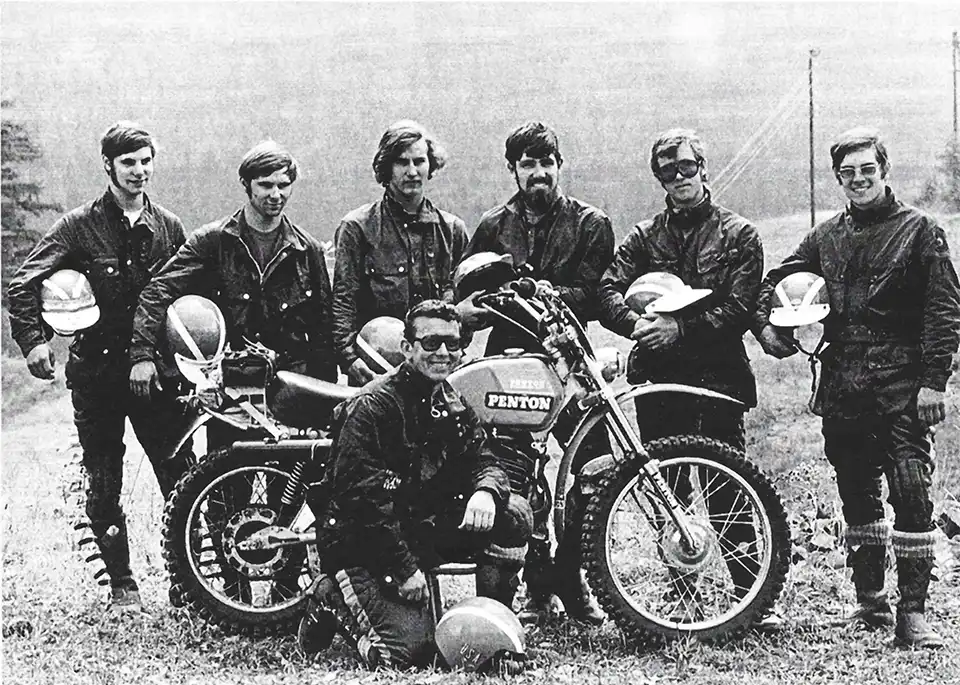
Photo by Jerry West
Doug Wilford is one of those low key, quiet, kind of guys that is unpretentious when you see him. But once you get him talking, you discover a wide range of talent, experience, and knowledge regarding Penton motorcycles.
Doug worked for John Penton from 1966 thru 1973. He was there when the idea of the first Penton motorcycle surfaced and when it all became a reality on the arrival of the first Penton Motorcycle. Working with Ted Penton in the sales and service department of Penton Imports, he helped solve the gear shifting problems with the Sachs engines.
His riding ability is world class. In 1970 he won an I.S.D.T. Bronze medal in El Escorial, Spain. In 1973 he won an I.S.D.T. Gold medal in Dalton, Massachusetts. In 1974 He won an I.S.D.T. Bronze medal in Camerino, Italy. The work load of the sales and service department were too great for him to attend the I.S.D.T. in 1971. After winning the National; Qualifiers in 1972, he gave up his I.S.D.T. ride to be a Team manager. As the US Trophy Team manager in Spinderuv Myln, Czechoslovakia his efforts were rewarded with the team being awarded with the "Watling trophy". (This trophy is in the AMA Museum and is awarded annually in recognition of best effort or most improvement during I.S.D.T. competition). It was the only time any US team has ever received this award.
Doug rode the 125 Penton during the time he worked for John Penton. The National Enduro series and the National Qualifying series were the main object of promotion for Penton. Doug had many class wins, a National Enduro Championship, and in 1971 missed the overall championship at the "Jack Pine" enduro by one point, losing to Ron Bohn on a 400 Husky. He was also the winner of three Berkshire medals - 1969, 1970, and 1972; and three gold qualifying medals ( 1972 at Trask Mountain and Busted Piston, and 1973 at Trask Mountain).
After Doug left Penton Imports, he went to work as Manager for Puch and continued riding Puch in the qualifiers and in 1974 rode a 175 Puch to a Bronze medal in Camerino, Italy. While at Puch, the Puch factory discontinued exporting motorcycles and the owner of Puch then started to import Hercules and Doug then continued to ride on the Hercules and was chosen by Hercules to ride the Wankel GS motorcycle in the 1975 I.S.D.T. at the Isle of Man in England. Only three of these bikes were made, one for Doug an American, one for Fritz Witzel of Germany, and one for Ivan Saravesi of Italy. Doug's was the only Wankel running at day four, when Doug retired with cracked ribs he received in a crash on day three.
After leaving Hercules in 1975, Doug left the motorcycling business and hip hopped from different jobs until retiring as a truck driver for lvacare Corp. in 1999.
To obtain more details about Doug for this article, I sent him a list of questions to answer and this is what he had to say:
What was your first bike?
"By bike I take it that you are talking motorcycle, right? Okay, it was a Whizzer that I bought for $50 from my paper route money. It wasn't the complete factory made model, those didn't come out till later. This was a kit that I put into my Schwinn Phantom framed bicycle."
What year was it and how old were you at the time?
"I think I was 13 or 14 maybe, that would be 1951."
In the book, John Penton and the Off Road Motorcycle Revolution, it was mentioned that you road a Whizzer in your first Jack Pine enduro. Tell us about it.
"That would take a lot of space, it could be a book on the adventures of a kid 16. You have to realize the environment that I was in. Amherst may be the Sandstone Center of the World, but it was also the heart of many motorcyclist. At sixteen I had helped build two club houses for the Amherst Meadowlarks. Most of my friends had a motorcycle of some sort, Cushman, Whizzer, Dot, James, Bantams, Hummers, Arials, Matchless, BSA's, and Harleys. I knew and rode with John, Bill, Ted, Ike (Pentons) and a lot of others. So signing up to ride Jack Pine was just a part of the equation. I had support crews, spectator crews, and a lot of friendly people to rely on. At sixteen there is no fear of something going wrong, there is just no fear, but a lot of anticipation, a sleepless night before the start, etc. To shorten the story, the Whizzer factory was there with 4 bikes and lots of spares. I finished, they didn't, end of story. There are a lot of great memories though."
Tell us your story about the first time you saw John Penton.
"Gees, I think I was 12 in the summer of 1949. Amherst has a lot of sandstone quarries and these make perfect fresh water swimming holes, of which every kid in town swam. This one particular quarry that I was going to with some buddies was at ground level and was usually much warmer (water temperature) than the others. But it had a long old two track that you had to walk or ride a bicycle to get to. Halfway up this path was an old timber bridge with all the planks missing, with only two big logs left of what was the bridge. The bridge wasn't real high, 6-8 feet maybe, but still you had to be careful not to fall off. As my group approached the bridge, we heard a motorcycle coming up the path. We stopped and got off the path in anticipation of what this motorcycle was going to do when it got to the bridge. Well, it never even slowed down. It went across one of those logs, didn't miss a beat, and there were two people on it. You talk about shocked, impressed, or whatever, that was something. Getting to the swimming hole, I found out that these two nuts on that Harley were Bill and John Penton. They were first impression daredevils!"
In 1966 you went to work for Penton Brothers. How did you get to be hired and what did you do there at that time?
"After 8 years in the military (USAF 1954-1962) I came home and got a job at the ship yard in Lorain, Ohio as an outsjde machinist. In 1963 I bought a Honda CB160 to make an enduro bike. John and Ted both were curious as to my choice. Bill Baird was winning all the enduros on a Triumph. My reasoning was it was a twin cylinder with the same power delivery but lighter and smaller. I began winning on this thing immediately. Other people saw what I had done and there began to be more Honda 160's showing up. Penton Brothers chief mechanic, Ralph Haslage, built one, then John Penton built one. John zeroed the Stone Mountain National Enduro on his Honda 160 on his way to Daytona. I think it was 1965 just before he started riding Huskys. The ship yard was mostly winter work, so I would work for Penton Brothers part time in the summer, until 1966 when I was hired full time as a mechanic."
When the Penton motorcycles came into the country in 1968, what was your job at Penton Imports with these new machines?
"Mostly I worked the warehouse, unloading the containers and shipping the bikes to the dealers, or setting up bikes for the riders. My Honda had spit me off so many times that I had stopped riding (from 1967 to 1968). Ted Penton was busy on the road setting up dealers and doing service work and I soon was working with Ted doing service work. Then we made the Research and Development (R & D) and I spent most of my time with Ted on R & D and service work, the shifting problem was just one of many were having and there was just Ted and I trying to play fire fighters. We hired John Cobb and I trained him to take over the service department in house while Ted and I went out to the dealers to take care of all the problems and set up new dealers. The R & D shop, and Ted Penton were the key to much of the Penton success. If there was a problem, he or we found a cure. The input was there, as all the race bikes, and riders, everything was right there, the machine shop, welding, fabricating, even our vehicle maintenance."
From my talks with you during the last 3 years, I consider you to be a serious and creative competitor when it comes to preparing your bikes for an event. Everything was well thought out and planned in advance by you which shows that you are not one of those "last minute" riders. In 1973 you and your Penton I.SD. T. bike were featured in a couple of articles of "Trail Bike" magazine where they wrote about what kind of prep work goes into an ISDT bike in order to survive the event. Last year, your 1973 Gold Medal bike which is currently owned by Joe Barker, was on display at the AMA Museum and in the Penton feature marque tent at Mid Ohio. Tell us about some of the prep work that you did to that bike that helped you win a Gold medal.
"Wow! Are you sure this will all fit in our newsletter?
Planning and preparation, to me, are kind of like: take your time and do it right the first time. I know it drove John crazy, as I have always planned ahead or tried to, and the Pentons were just "do it" types. In the beginning, when I went back to riding, after Sundays races we were always back to work on Monday so Monday night the bike was washed, tore down, whatever. On Tuesday night it was put back together and made ready for the following weekend. Our dealers and our riders always had priority, so I did most of my personal work after work. Our dealers and riders were always wanting or needing something different. That is how we grew stronger with their input. Oops, sorry I can easily be sidetracked. I guess what I am trying to say, I had to be ready early. When we would pull into a race site with the Penton "Cycleliner" there was no time for me to work on my bikes, there was always a crowd of customers that wanted or needed something. Sometimes it was even our own team, which really irritated me, because they weren't ready. But, when I look back, they were only kids, Jack, Jeff, Dane and most of our riders."
"Prep work on ISDT motorcycles, I was bad, maybe I was the worst. I probably had more time in preparation for the 1973 six days than riding it. Enduros are a game, the ISDT is a game. In most sports the person with the best equipment and the best preparation have the best chance to win, right? My planning was to have as many spares and as many tools so that I could fix anything in less than 4 minutes. Chain, the Berkshire area is famous for wearing out a chain. I had a spare made up in a box mounted on the front of the frame tubes. Bully Uhl said if there is such a thing as reincarnation, let me come back as a chain on an ISDT bike, because they get the best care in the world. If you fall and break a rear shock, a marked part that wasn't replaceable, I had a spare shock body mounted on the frame in front of the air box so it could be marked as replaceable just like an extra throttle cable. Everyone does that."
"Tom Penton mentioned it would be nice if someone would come up with an anti-flood device for the carburetor, and he did. As all of the pre reed valve people know, if you fell down, most of the time before you got your bike upright, it was flooded. You turned off the gas and kicked it until it started, then you held it wide open until the float level (in the carb) got back to normal and the engine cleaned itself out and off you go again. With Tom's device it was very simple and easy to do. He tapped into the float bowl in the bottom with a fitting to which you put a long piece of fuel line long enough to reach about 2-3 inches above the cross bar of your handle bars. A paper fuel filter was placed in this fuel line under the tank someplace and presto you have an anti flood device. When the bike falls over and it is flooded, one big suck on the tube emptied the float bowl and away you go. The filter in the fuel line keeps the gas from getting in your mouth."
It was on this bike that you claim that you had the world's first folding shift lever. How did you make it?
How and why did you come us such an idea?
"Riding enduros you see a lot of different ideas. I don't know which came first, the skid plate or the air filter, then the brush guards and chains or cables to the ends of your foot levers so the rocks and roots didn't put a 180 in them or make them disappear. At. R & D we had developed the brush guard and a shorter shift lever for the Sachs engine, one to prevent over shift and two to be more out of the way. Well, Tom Penton says he doesn't remember and maybe the mentioning of a folding shift lever was so casual that he has forgotten. But when he (and I am almost positive it was him) mentioned it to me, bells and whistles went off in my head, and I had to make one. But how and with what! Some of the early Sachs kick start levers would break and the foot part would go back around, hmmm (thinking), we had a few of those laying around somewhere. Using that as the swivel and cutting off the rubber part of the shift lever, I had a place to weld the swivel, now, how to keep it out so you can get your foot on it. Old enduro riders live by inner tube rubber bands, baling wire and duct tape. I did one better. I used the inner tube rubber band and tywraps, going from the brush guard to the shift lever. Simple and crude but it worked. Hind sight is 20/20 but of all the great innovations that Pentons had, this one could have made us all very wealthy. I don't believe there is an off-road motorcycle today that doesn't have a folding shift lever."
What was the first event that you rode a Penton motorcycle? Did you finish? How did the Penton do against the other bikes?
"As I mentioned before, I had quit riding. I think it was December of 1968, and one cold wintry day, that John asked me if I wanted to go with him to ride a Hare Scrambles down in West Salem, Ohio. I didn't own any motorcycles and I mentioned this to John. He said I could ride one of his. It was a nasty cold, slippery slide around event, but was I in for a surprise. The handling of the Penton was so good and so much fun in the slides, it was like I couldn't fall down. I think maybe Al Born beat me on a Penton, but I got a trophy, and that was the beginning of the 52 weekend years. The other bikes, if they weren't Penton or Husky, had little chance."
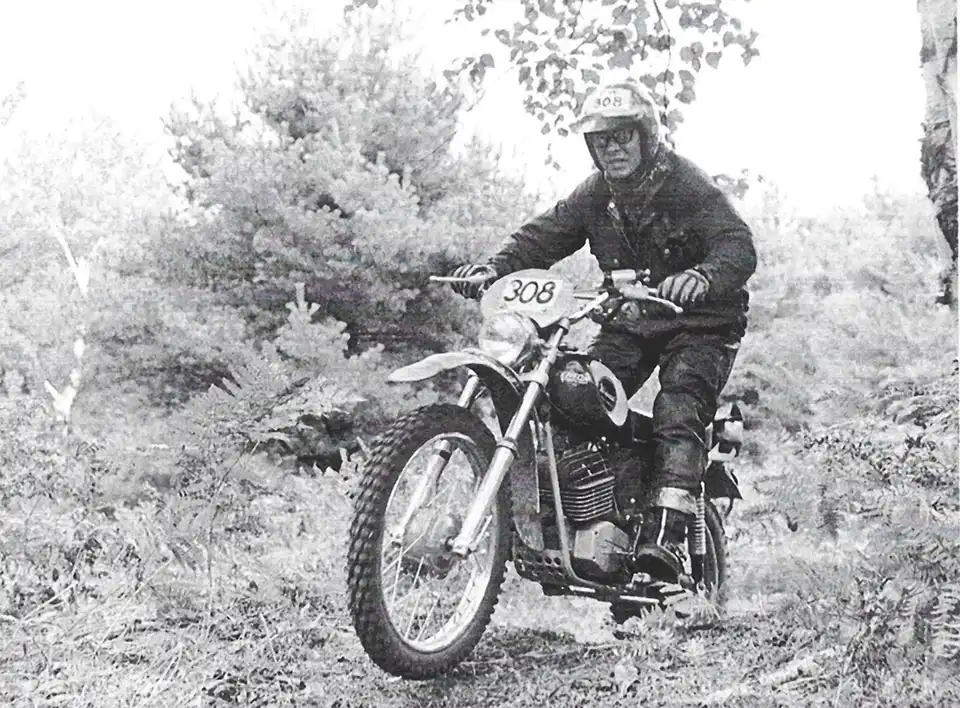
In 1972 you were the manager for the US trophy team in Czechoslovakia. What were some of the behind the scene job as team manager in the US before going overseas?
"You know this whole article is tough to do. Most all this stuff was done when my family was growing up without me. My wife is a saint and tolerated all of these times and very seldom got to enjoy what I was enjoying. I'm not proud of that, and I can't say it was all my doing. I just happened to be where I was at the time."
"The 1972 Trophy team was of course all on Pentons: Dick Burleson, Jeff Penton, Dane Leimbach, Billy Uhl, Carl Cranke, and Jack Penton. All young and talented. I had ridden with all of them quite a bit except Carl, and his credentials were outstanding. I had two objectives with the team, physical training and personal preparation. We ran at the local High School track a few times, and I had them change tires till everyone was under four minutes. At times it was fun. Behind the scenes, John and his manager Bob Mahutta were putting together a tour, a chartered plane, and 300 people (some to ride or tour the Danube, some to tour the KTM factory, some to go to Czecho. for the Six Days). The riders were to do a part of the Danube, go to the factory to prepare their bikes, then go behind the Iron Curtain to Czecho. We had wives and girlfriends, mothers and fathers, and my mom and dad whom had a great time. I don't remember having much time to visit with them."
"Logistics for the team was luggage. How to take all your riding gear and stay under 22 kilos (about 44 lbs.)."
What kind of changes were you trying to make to improve the trophy team's chances of winning over the previous years efforts?
"Unity. To be a team and not an individual, follow directions and believe in the planning. You ride as an individual, but you cannot forget that you are part of the team. Everyone tries to do the best he can possibly do. We did that and were awarded the "Watling Trophy"."
What were you involved with when you and the team arrived in Czechoslovakia?
"The team and the KTM factory support vehicles and people went to Czecho about five days before the event was to start. Our Hotel that was reserved for the Penton tour was still cleaning up to get ready for the tour which was due in about two more days. I have to say, you must remember that 1972 was before the Berlin wall came down. Crossing the border, into Czechoslovakia with the mine fields, machine guns, and iron gates was not an easy feeling. When we arrived in Spinderuv, the soldiers (officials of some sort) told me we had to stay in the riders hotel, at $9.00 per person, per day. I objected, saying we already had rooms at the Hotel in town with the tour group, and then took the riders and families to the Hotel in town. Little did I know about how the Red Army operated. But, if you are supposed to be in a certain place, they expect you to be there. At the "Penton Hotel", when everyone had their rooms, I went down to the lobby and was looking at a newspaper when in comes a General and three machine gun toting soldiers. He marched over to the desk clerk and started asking questions. Well, I don't understand Russian , but "Wilford" sounded pretty much the same and I wasn't going to stick around long enough to find out what he wanted. I played "Houdini" every time the General and his buddies showed up. This hide and go seek went on for three days until the FIM International Jury showed up and I pleaded with them to find out why I was a hunted man, and they fixed it. It was because my riders were not in the proper Hotel. Whew, not fun. I never saw the General or his companions again."
"We rode quite a bit of the terrain and the road race course before the start of the six days. In the preparation meetings the hardest part was, we did not know how to pronounce the names of the village we were to ride thru. We changed the names on the maps with like sounding names (example: CZ = Blmna / ours = Banana). It was a wet and miserable Six Days. I don't believe the sun ever came out while we were behind the wall."
Since your job was to manage the Trophy Team, how did you deal with the US non-team riders?
"Okay, I have heard I didn't make any friends. The people that know me, know I always try to be fair. But, when the game face is on, I am very serious. The whole tour was to be handled by others and all I had to do was take care of the team and the visas to Czecho. I somehow got to be the tour guide the first night in Vienna with rooming lists and bus schedules. By the time we got to the KTM factory, my fuse was a bit short. Somehow the team was blessed with some last-minute nylon lined throttle cables, two for each rider and a spare for the support truck. Taking care of the wants and needs of the team was a handful, and when I was approached by another US rider wanting the spare nylon cable, I told him to use a standard cable as a spare and my tone of voice was probably not too good. This story has been on the Internet, and I can't say the circumstances were the same I would do the same thing." What were you involved with during the Six-day event and what kind of problems were you faced with and how did you try to solve them?
"Every morning at the Pare Fenne, it was serve up the nerves time. As a rider, you pretty much only worry about your bike (do all the tires still have air, will it start, etc). As the manager, you multiply that by all the bikes and riders on the team. As each of your riders come to the line, it is prayer time, for their safety, and if the damn bike will start."
[Editor's note: at the ISDT events, riders were not allowed to start up their bikes in the morning until they pushed them up to the start time on their allotted starting time.]
"In those days, chase riders were not allowed, so I rode from checkpoint to checkpoint via short cuts to stay up with the riders and assist in any way possible. One day Dane had used his spare spark plug and wanted a couple of spares. Somebody had a flat and need another tube. There was always something during the day."
"At night, we had meetings to review our needs and the next day's course and schedules. I also had meetings with the AMA. One time we were protested and had to meet with the FIM Jury for using CO2 cartridges to put air in tires. None of the Europeans had ever seen them. We had the trick stuff. After the jury saw what the CO2 was, and not allowing the protest, it probably helped us get the Watling, that and the US Trophy Team riders taking all of the front row positions for the road race. We had ridden the road race course before the event and it was raining, so when all the other competitors went to take the practice lap , I had all of the Trophy Team stay in the start grid and then take the front row positions. This was okay as the rules stated, the practice lap was at the rider's discretion. This was not against the rules and showed good management."
How did the riders do during the event?
"Not good enough. As a team, we didn't win. Each and every one of these riders has at least one gold medal in the Six Days, and most, many more. But the whole team has to be gold and high in points of their class to win the Trophy Team Trophy."
Where you surprised when you and the team were awarded the Watling trophy?
"Everyone was surprised. The jury were the only people that knew ahead of time and the AMA jury guy didn't give us any clues. It is one thing I can be most proud of, managing the team that was awarded the "Watling Trophy ". This is something that no one else has ever done, in the US that is."
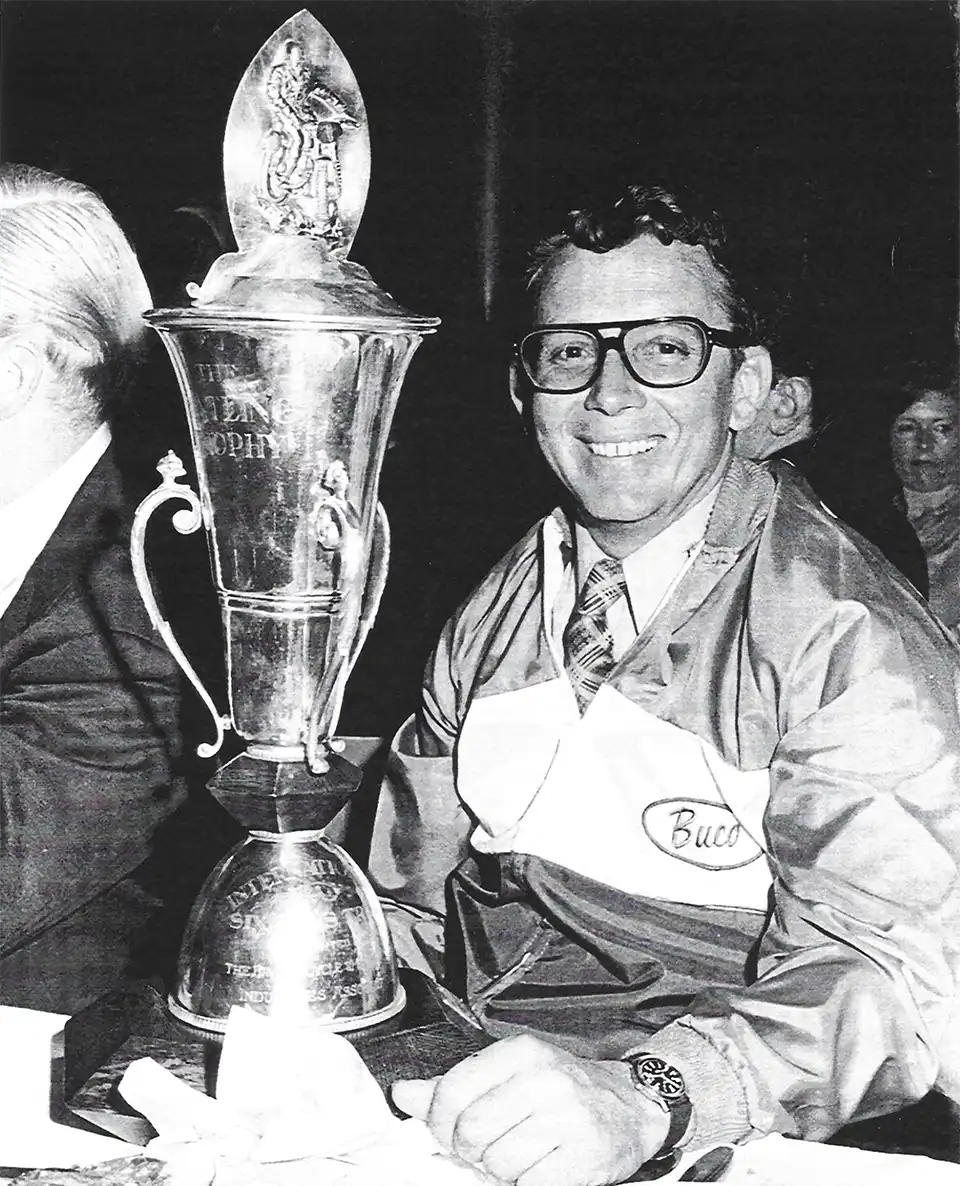
Photos
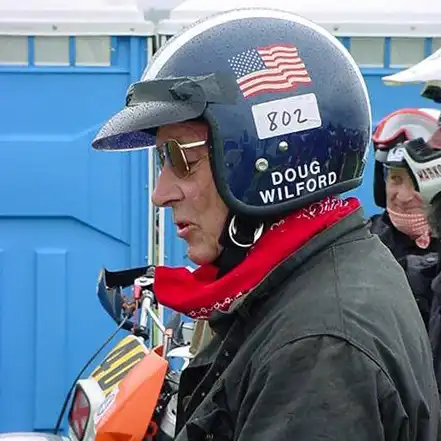
Photo by Bill Smith
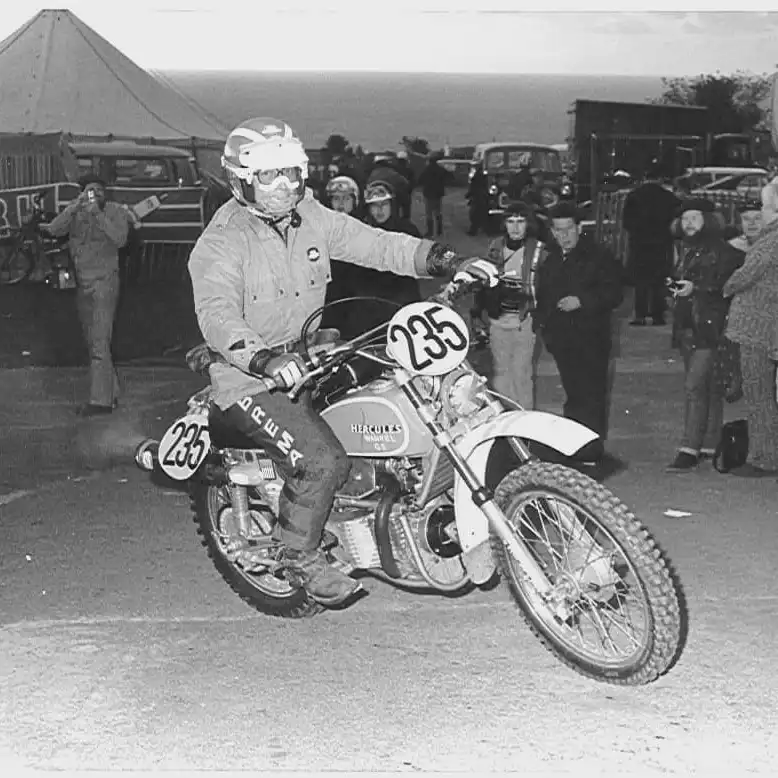
Penton Rider Profile
Originally printed in the 2014 issue #64 of Still….Keeping Track
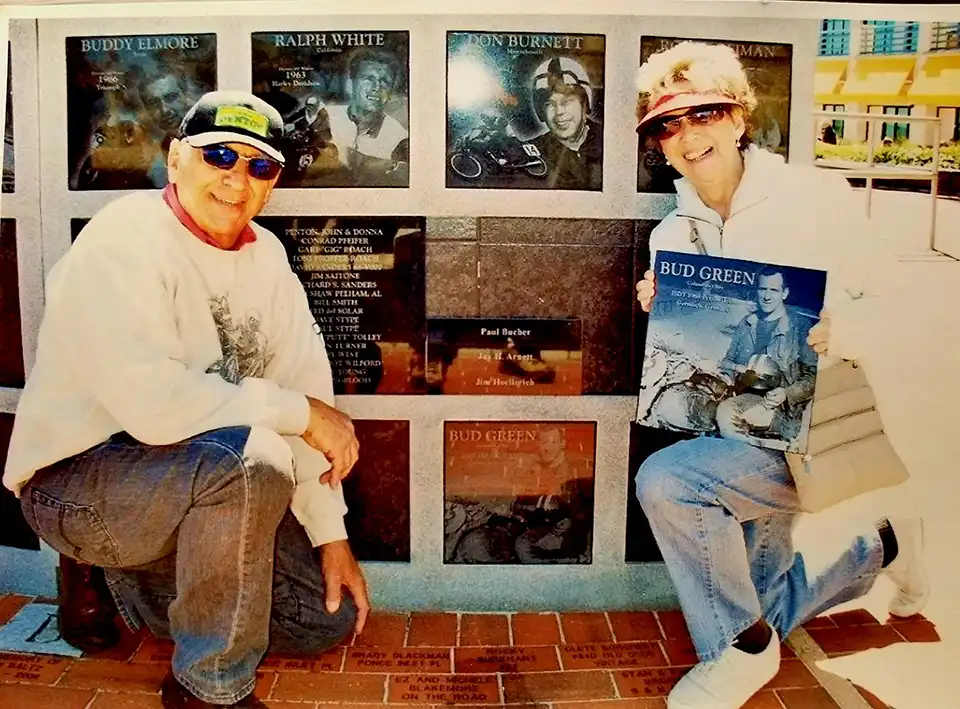
During my career as a motorcycle competitor, I rode for 3 of the kings of motorcycle competition-Bobby Hill, Dick Klamfoth and John Penton. My appreciation and thanks to all three. All three riders won many National Championships, including Dick's 3 wins at the Daytona Beach 200 on a Norton Manx and Bobby's win at the Daytona Beach 200 on a BSA. They also rode half mile dirt track. John won many National Championships including the Jack Pine 500 National Enduro.
I was born in Columbus, Ohio on March 6, 1935, being the 6th in a family of 10. My first bike was a Whizzer shared with my brother Bill. I was introduced to motorcycles by Victor Franks, father of a childhood friend. Victor had a 1945 Harley with a sidecar which he fixed for enduro riding and I was his passenger and this got me hooked.
I rode mostly enduros and motocross in the fall as a solo rider and also as a sidecar passenger with Jack Pflug until I met Bobby Hill at Shoppes Indian Shop in Columbus, Ohio. I starting racing half mile for Bobby on a 1948 Indian Scout. The racing bikes at this time did not have brakes. My first race going down the straightaway with no brakes was a thrill. I was 16 years old at the time and a parent had to sign for me to get a license. Mom thought I was only riding in circles, but my Dad knew better and never told Mom just what the "circles" entailed.

My novice year with Bobby as a half track rider was pretty successful and I was runner-up in the Columbus Star Hall of Fame. It was at this time Dick Klamfoth offered me a ride on a Norton Manx for the Daytona Beach Road Race 100 mile event. After talking my Mom into writing me an excuse for absence from school, I was sitting on the Daytona starting line on my 17th birthday. The highlight of this trip was a telegram wishing me good luck from Marvin Dountz, a friend from Columbus, Ohio.

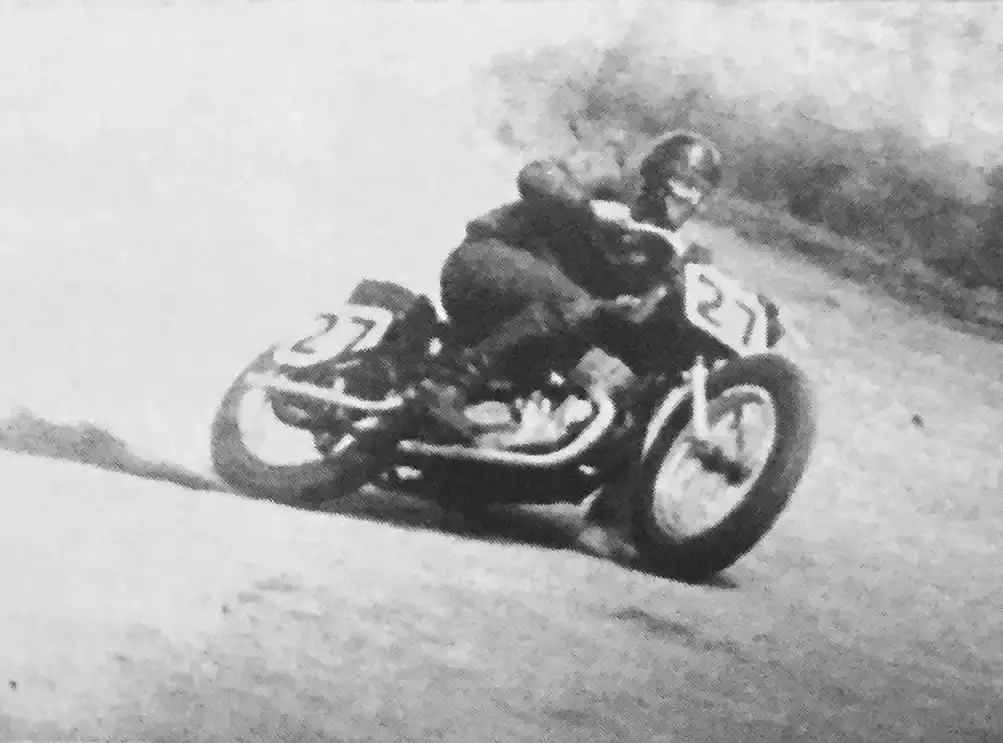
I was sitting on the starting line at Daytona with butterflies knowing there were 90 riders. Starting on the beach was like riding into a sand blaster since the front straight-a-way was the beach. The back stretch was asphalt with bikes carrying sand onto the surface and the corners were very deep. The sand on the asphalt made the road very slippery. The back stretch was a very rough ride. The beach stretch was very smooth with deep sand in the corner. The beach course was a lot different from the flat track courses. The straightaway was sand, with deep sand in the corners, and out of the back stretch was asphalt (Route lA1). Top speed was much faster than the regular half mile track and starting with 90 riders and having to watch for the markers indicating going into the corners made this race more dangerous. This type of racing did have front and rear wheel brakes. On dirt track racing half mile and mile dirt tracks, brakes were not used. Going into the comers it pitched the bike sideways sliding into the comers. I was running in the top five when the clutch went out and I was unable to finish the race.
Bill Reese, a BSA Dealer out of Dayton, Ohio, whose son, Donny Reese also road half mile, offered me a ride on a BSA Twin rigid frame. I rode this bike in the 1954 Daytona 200 without much luck - I lost both foot pegs and was riding with my feet on the pipe and after burning holes in my boots I couldn't fmish the race. This was my last ride on the beach.
I rode a year for Dick Klamfoth on a Manx Norton. I rode half mile from 1951 to 1957. During those years I rode for several motorcycle dealers, including Smitty's Harley Davidson in 1954. In 1955 I bought a Harley Davidson KR Race Bike from the Harley Davidson Factory. In 1956 I was ranked 4th in the National standings (having 13 first place finishes, 16 second place finishes and 13 third place finishes).
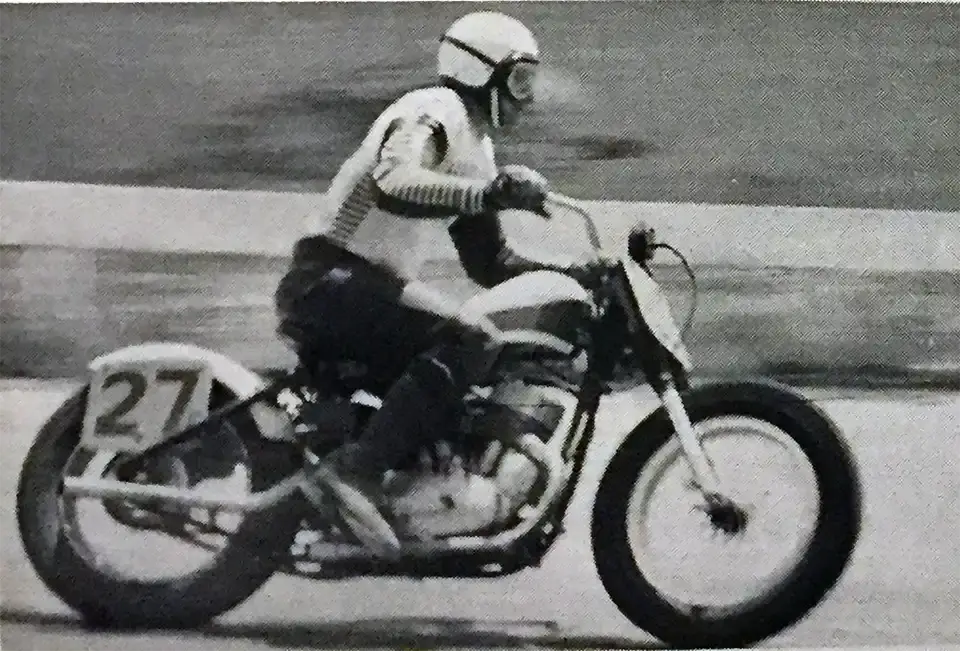
I met my wife at an enduro in Greenville, Ohio. We were both 16 and Pat was there with her aunt and uncle, Jack and Evelyn Pflug. The Pflugs were active in the Buckeye Motorcycle Club and Jack was a side car competitor. He was a strong little guy that was very good at piloting one of those rigs. I know because I rode in the side car many times with him. Jack was a very good competitor, winning the side car class in an Ohio State Championship and many local Ohio Enduros. The side car passengers figured the time and time schedules and in many cases shifting around for better traction and holding the side car down. The passenger always bad to be ready to get out and PUSH.
Jack was a Charter Member of the AMA with the member No. 133. I was a Charter Member also, but with a much higher member number. Jack requested that the AMA (Ed Youngblood) assign his member No. 133 to me after his passing which I still have today.
Pat and I have been married now close to 60 years. We have two sons and four grandchildren. Motorcycle competition has been a big part of all our lives. Pat and the boys would gas for me on most local runs.
I started riding enduro races again in 1957. I rode several brands of motorcycles, mostly 100 cc and 125 cc. and the wins included the Ohio State Championship (Athens, Ohio) on a Triumph Cub 200cc, and placed 2nd overall on a Triumph Cub 200cc in an Ohio State Championship, l point behind John Penton; the Baby Burr Enduro overall on a Harley Baha 100 cc; the Ball and Chain enduro on a Honda 250cc and the Milk Run Enduro on a Triumph Cub 200cc.
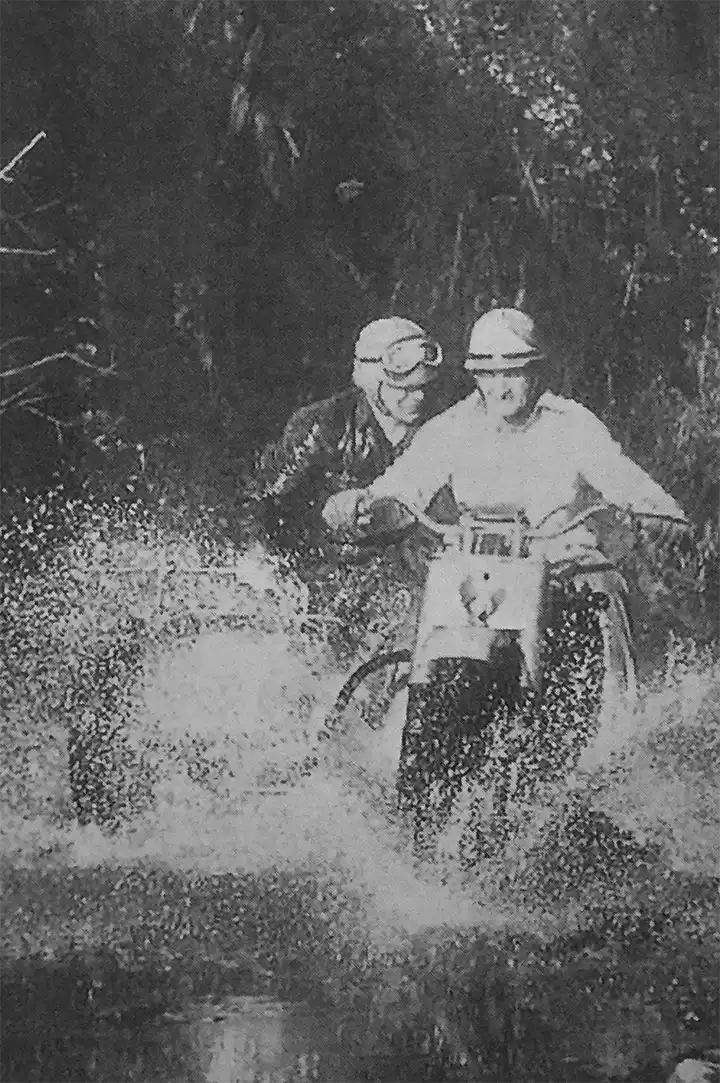
In 1965 I purchased a brand new 500cc Triumph Trophy to use for enduro riding. The modifications I made to it included installing a solo seat, changing the gas tank to a Triumph Cub 200cc tank which was a smaller tank with as good gas capacity. I also made a larger air f1ltcr with air intake under the seat. I completely repainted the bike to orange and white. The completed bike was trailered up to Michigan to ride the 1965 Jackpine Enduro.
It was during the 500 mile Jackpine Enduro, on the second day that I ran into a Jeep. The Jeep was crossing a trail section trying to get to a spectator area along the course just as I was coming down the trail. I couldn't stop and my Triumph slammed into the side of the Jeep. I flew over the handlebars into the Jeep knocking myself and one of the passengers in the Jeep out. In the hospital a doctor was removing orange paint from my mouth from my bike.
In 1968 John Penton contacted me to ride a 100cc Penton. I won several class national championships and overall national championships in the Bantam Weight class at the 500 mile Jack Pine Enduro. In 1969 I started riding the Penton 125 and won several national class championships. It was at this time that John Penton approached me about competing in the 1969 ISDT trials in Germany. In the 1969 Jack Pine 500 Enduro, John Penton won the overall national championship, I won grand champion on the 125cc Penton. In 1968 and 1969 the Penton team (John Penton, LeRoy Winters, Dave Mungenast and I) won the team championship in the Jack Pine 500 Enduro.
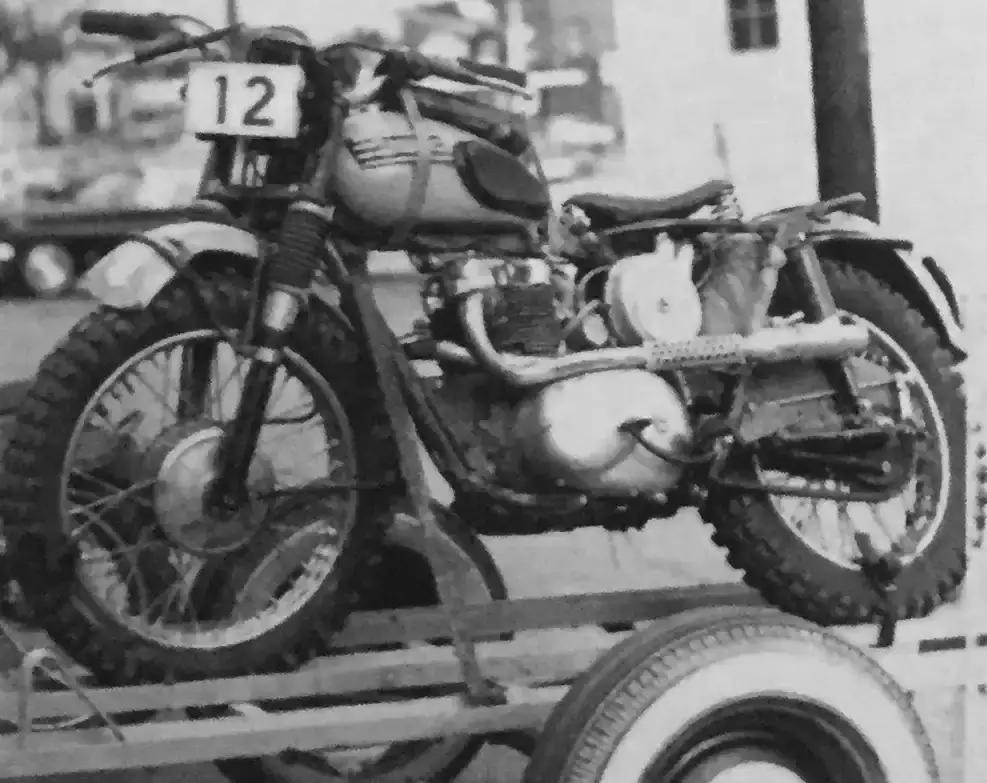
I started riding for John on a Penton 100cc factory ride. The Pentons were pretty much ready to go for enduros without much work. Most of the other bikes I rode did not come with knobby tires, did not have high exhaust pipes, proper air filters, or water tight sealing, all of which the Penton came equipped with. The only modifications I made to make it ready for me to ride was taking the grips off and sealing the openings at the end of the handlebars. Having big hands, I always made the grips larger. I did not like the lock washers, I preferred all flat washers. I always greased the inside of the air filters and I also bent the handlebars back to suit me. I started riding the 100cc Penton in 1968 and during the entire season of the National Enduros, including the Jack Pine National 500 mile event, I did not have to make any kind of repair to the engine, including rings. However, I did prefer the power of the 125cc over the 100cc.
I have known John for years and I never thought that I would be offered a factory ride. When John offered me that opportunity I did not think twice about it.
After the 1969 Jack Pine event John Penton, LeRoy Winters, Dave Mungenast and I left for Garmisch~Partenkirchen, Germany, for the 1969 ISDT 6 day trials. Our team finished 9th, with John, LeRoy and Dave winning Silver Medals and I won a Bronze medal. An AMA official informed me that I was one of 4 or 5 riders who competed in both the ISDT trials and the 200 Race at Daytona Beach Florida.
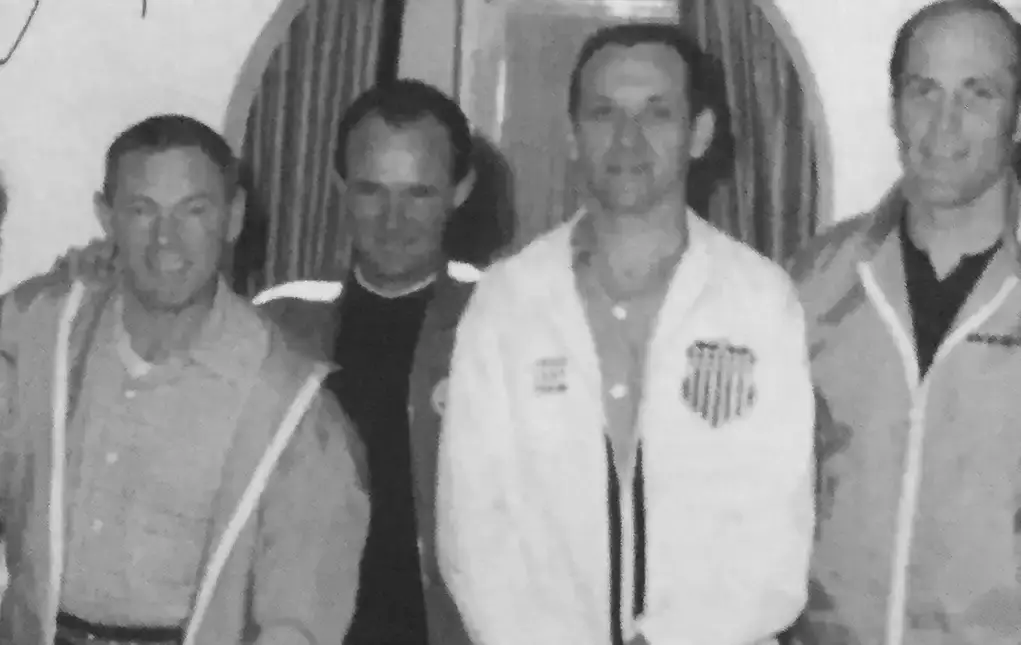
The trip to Germany started on an upbeat note with John winning the Jack Pine 500 National Enduro and our winning the team championship. This was Pat's and my first trip by air travel and it was a nice group to be traveling with. Our group consisted of our team, along with Donna Penton, Pat Green, Jerry West and Ted Penton. Like everybody knows, Leroy was always a character and we had a good time joking around. Dave was more serious having broken his collar bone at the Jack Pine, but he remained upbeat and liked to have fun. We actually did not have too much time to play around. The two days before competition were used as practice days before the bikes were inspected, motors sealed and put into the impound area. Each night after riding we would have a meeting with the factory representatives and riders, then dinner and the evening was about over. Our day started at 6:00 A.M. and this made for lomg days.
At dinner time during our trip, John took it up himself to stir the margarine for our bread. Margarine back then was white and had to be colored with a yellowing agent to make it look like butter. We all got a kick out of this and would kid John about it.
Since John won the cowbell at the Jack Pine and I won second overall, I happend to see a small cowbell in the lobby of the hotel and thought I had a chance to also have one and got caught. I was called an American thief. Not my finest hour.
Pat celebrated her 35th birthday on the trip with a birthday cake from Leroy.
On our arrival in Germany, the Penton team was invited to dinner at the home of Erich Trunkenpolz and he gave each of us an embossed Sachs gold coin.
Everyone got along and we had a great time.
In 1970 I won the 100 mile National at Stone Mountain, Georgia on a 125cc Penton. I continued riding the Penton for several years.
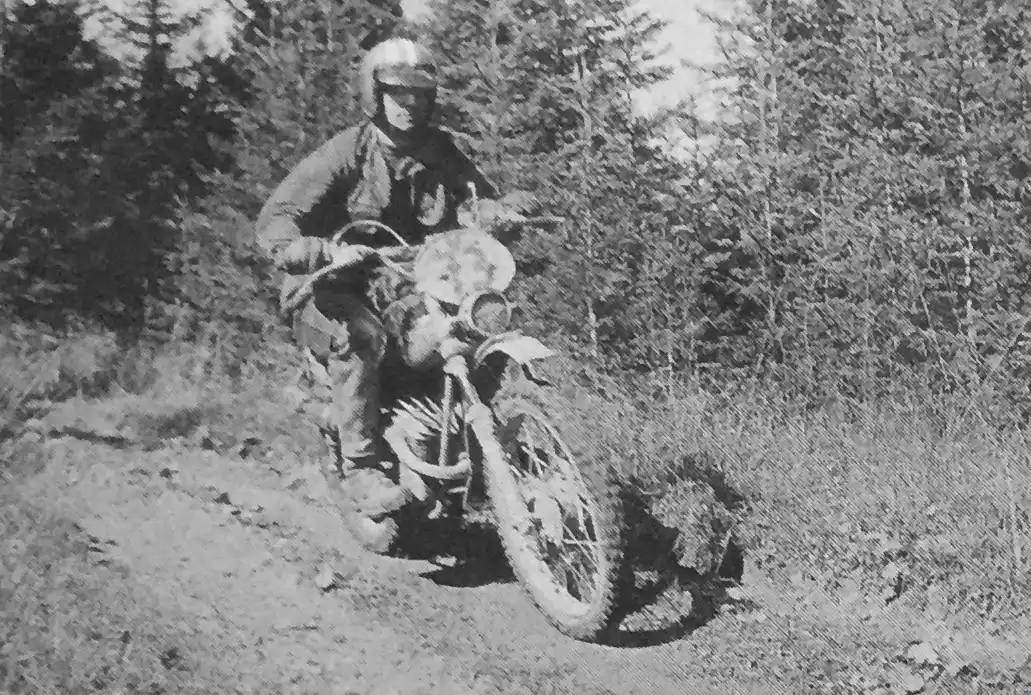
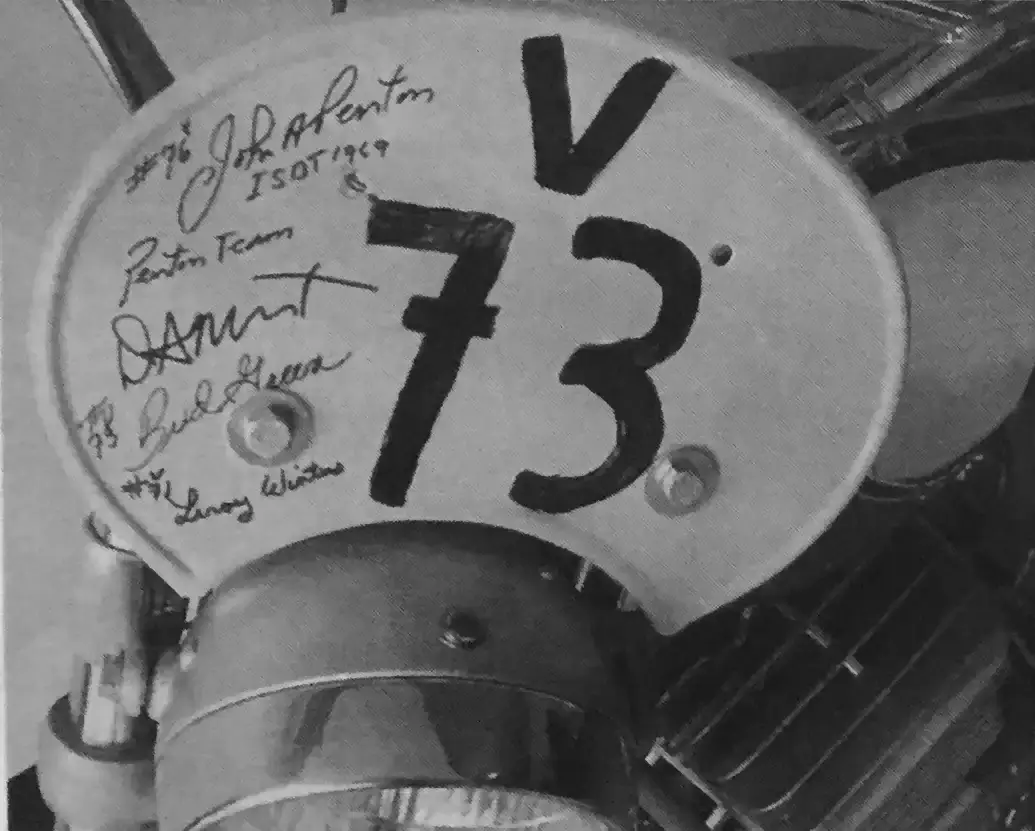
I did not ride much for a few year while my boys were young and eventually got away from it. On a vacation one year at the Daytona Beach 200 mile event I stopped for lunch at "Boondockers" restaurant to eat. I was sitting at one of their picnic tables and I happened to see a gentleman across from me who was wearing a "Team Penton" cap. I went up to him and asked him if he owned a Penton motorcycle. He happened to be Nelson McCullough a POG member from Pennsylvania. We exchanged e-mail addresses and communicated back and forth when we got back home. Nelson contacted Paul Danik about me, who in turn talked to Ed Youngblood. Since Ed lived in Columbus at the time, he got in touch with me and brought me to one of the POG meetings. This is how I became involved with the Penton Owners Group. Shortly after this, John had a picture plaque of me installed on the Penton Wall of the monument at Daytona Beach, Florida.
Through the Penton Owners Group I got to know Bill Smith. Bill is the one who got me interested again in riding. This interest took me into renovating old bikes and with Bill's involvement I am now restoring several Penton motorcycles.
The years of motorcycle racing have been good to me.
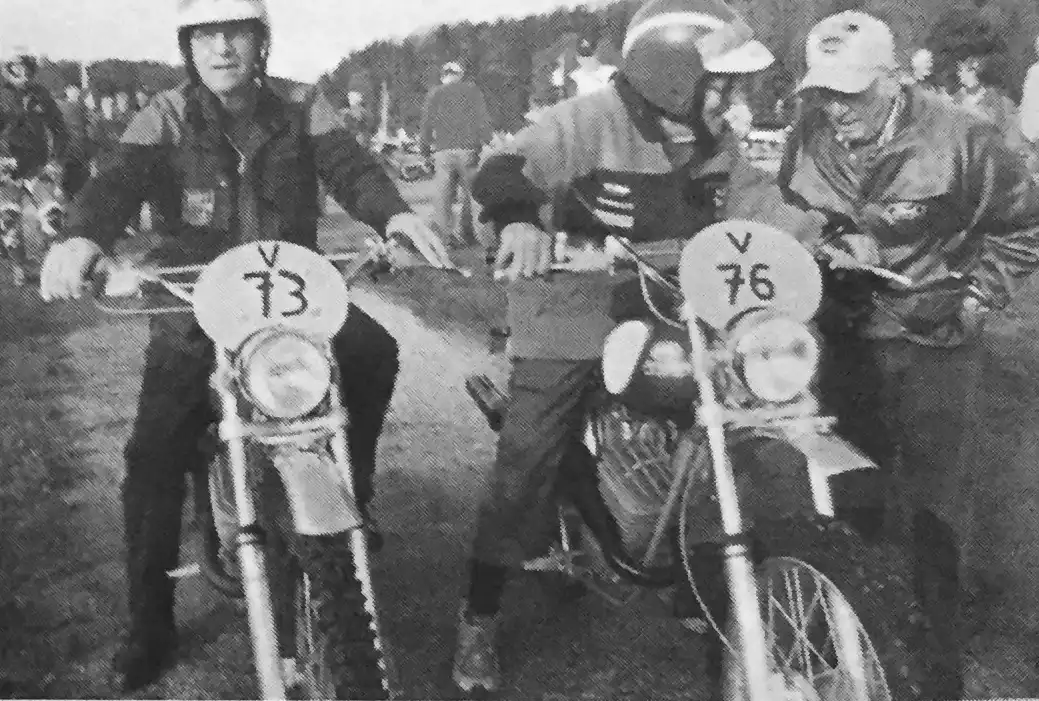
photo by Bill Smith
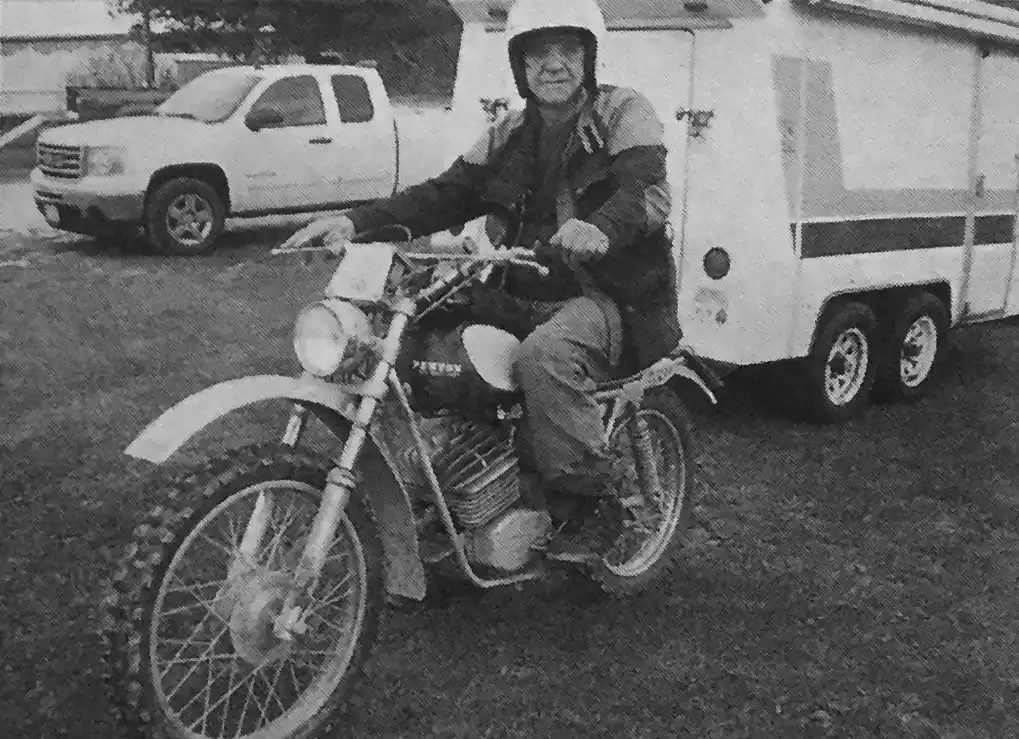
Videos
See also...



